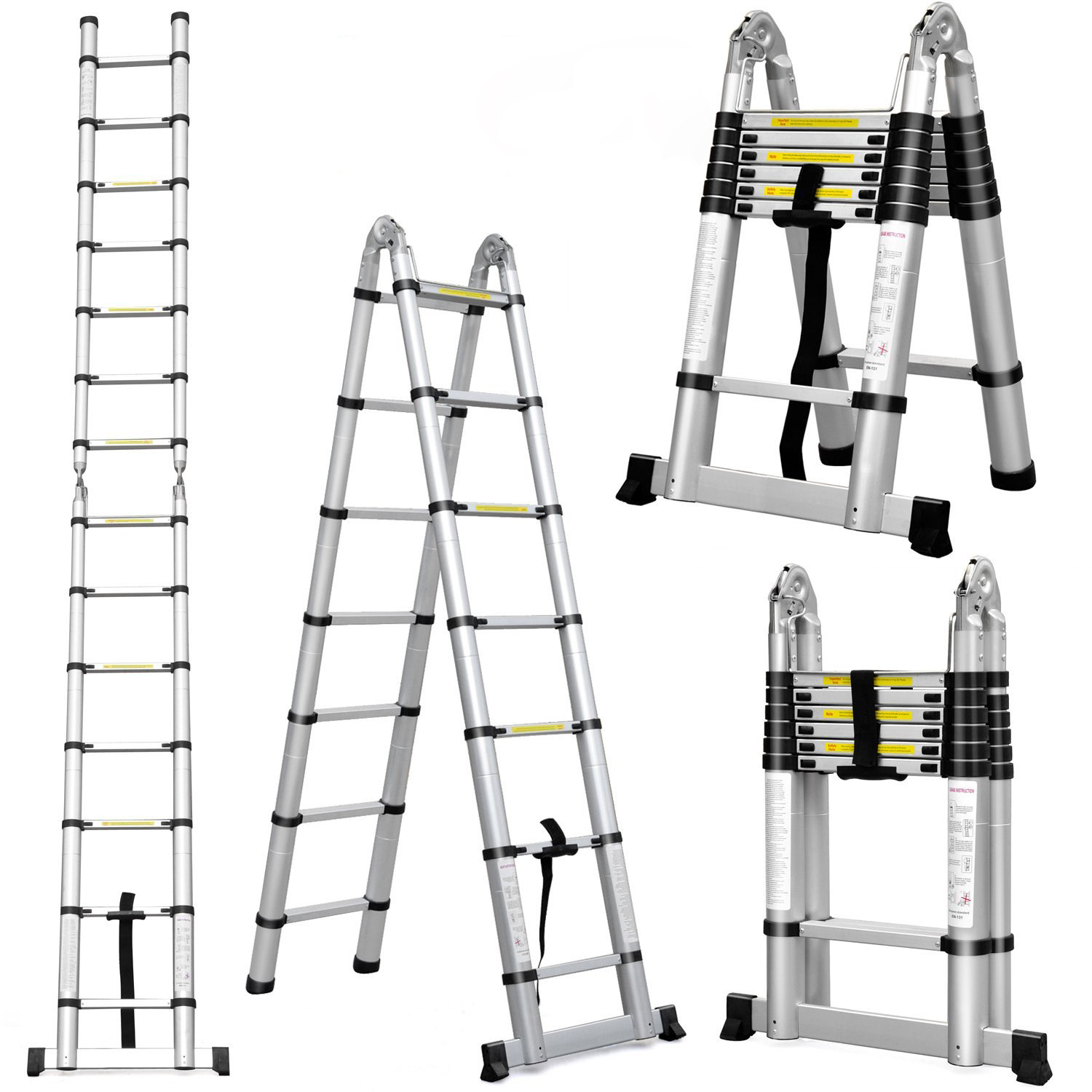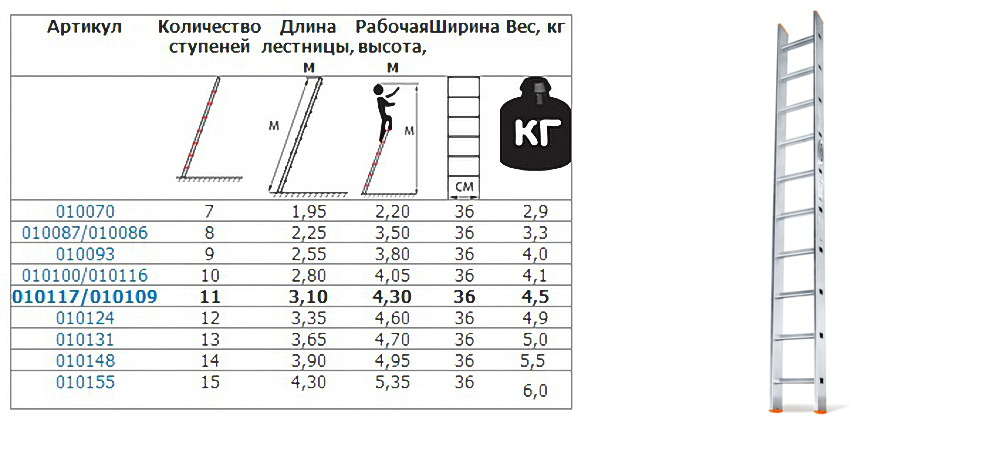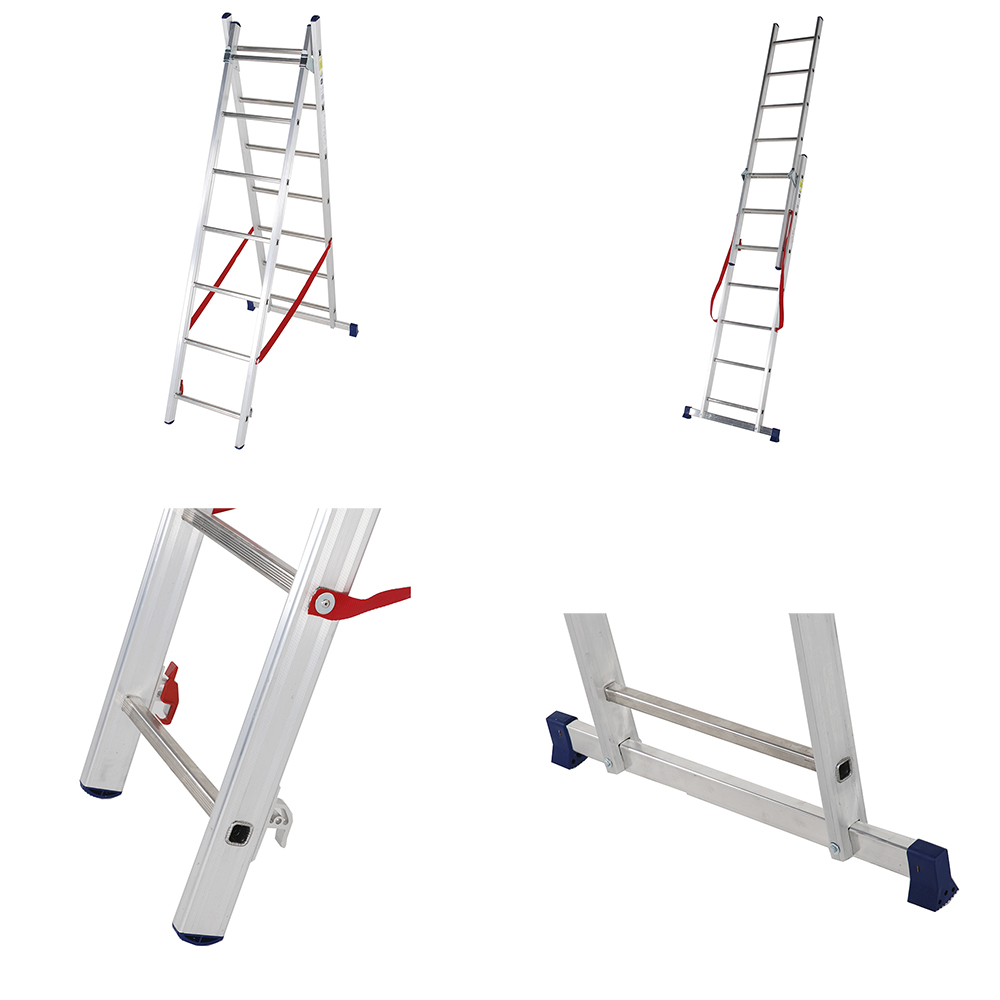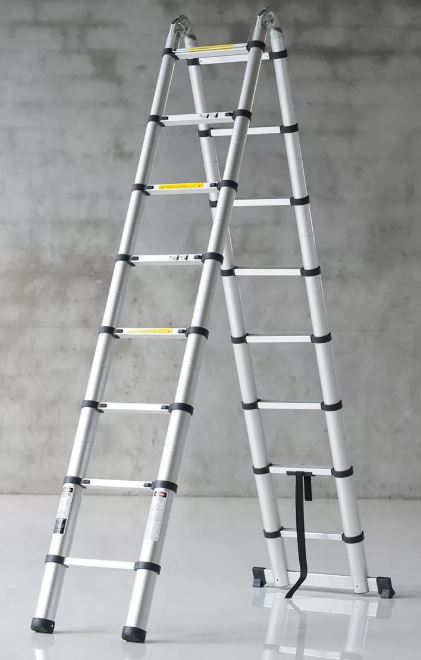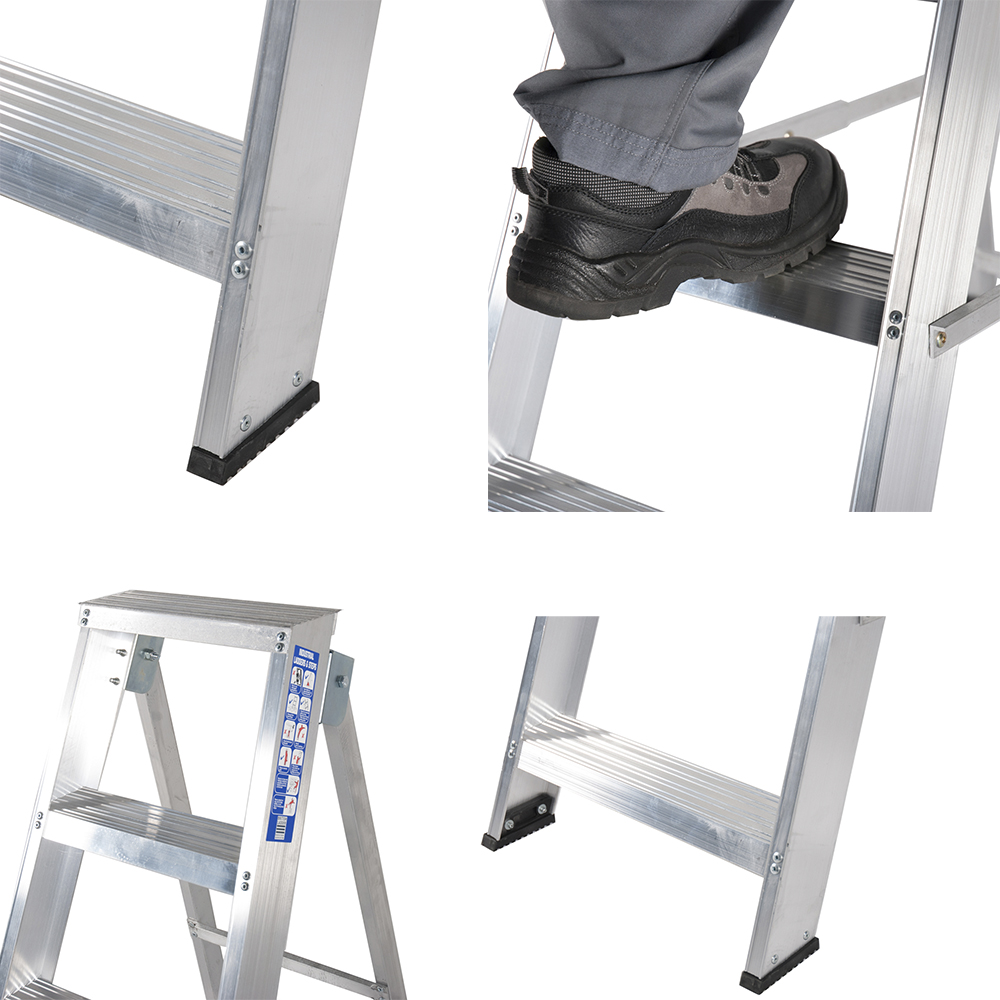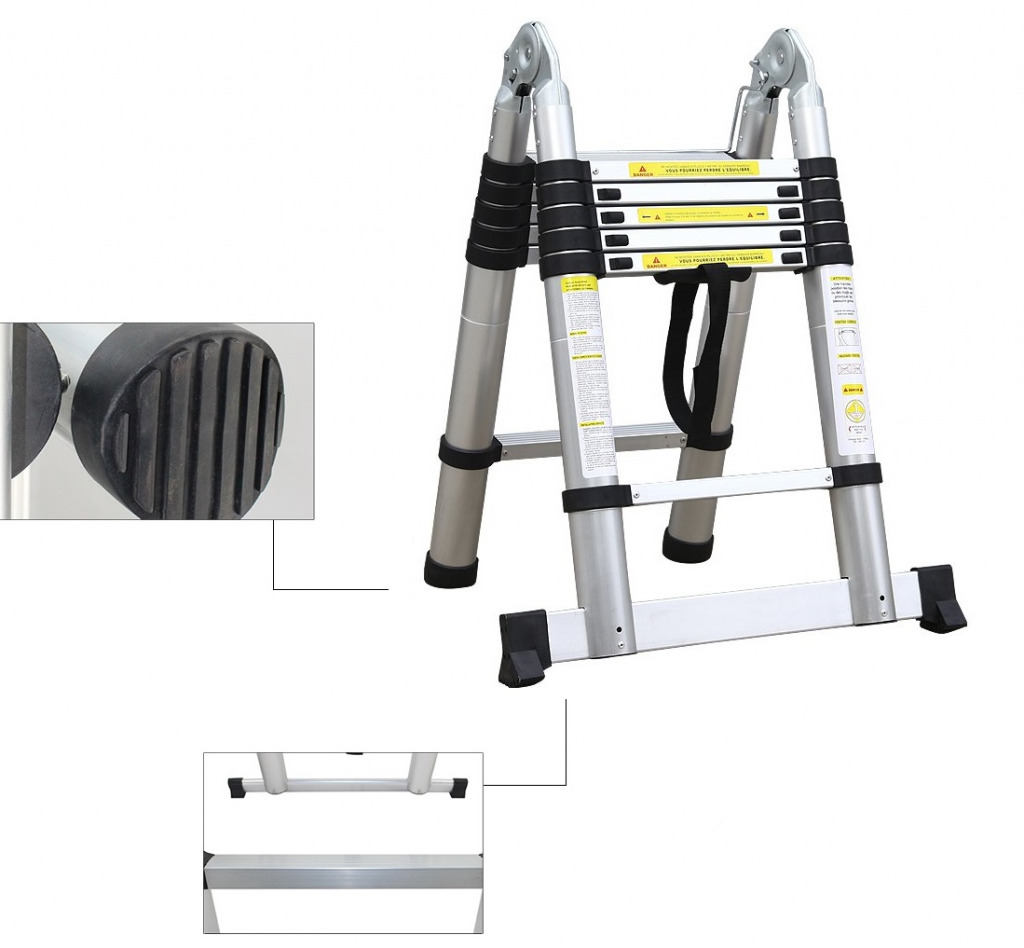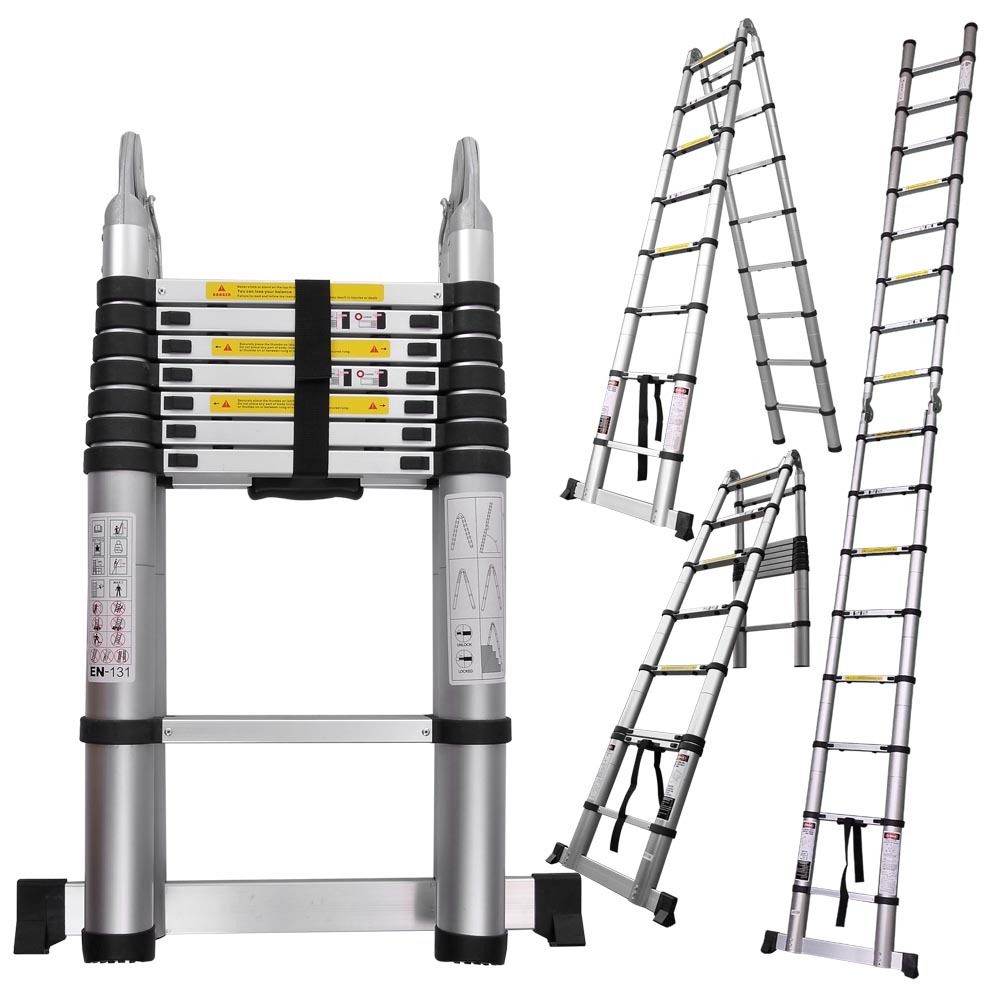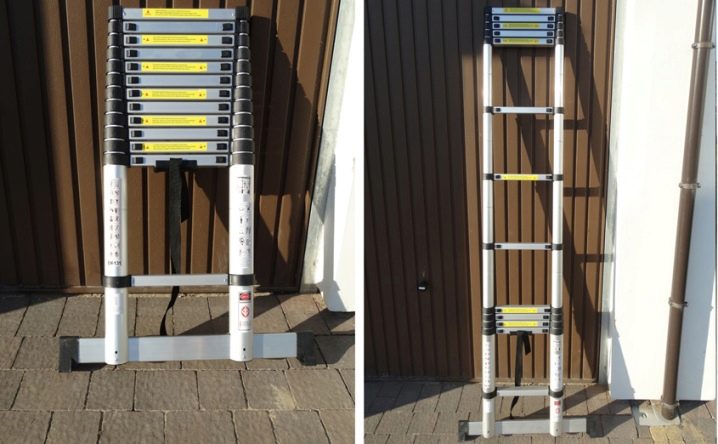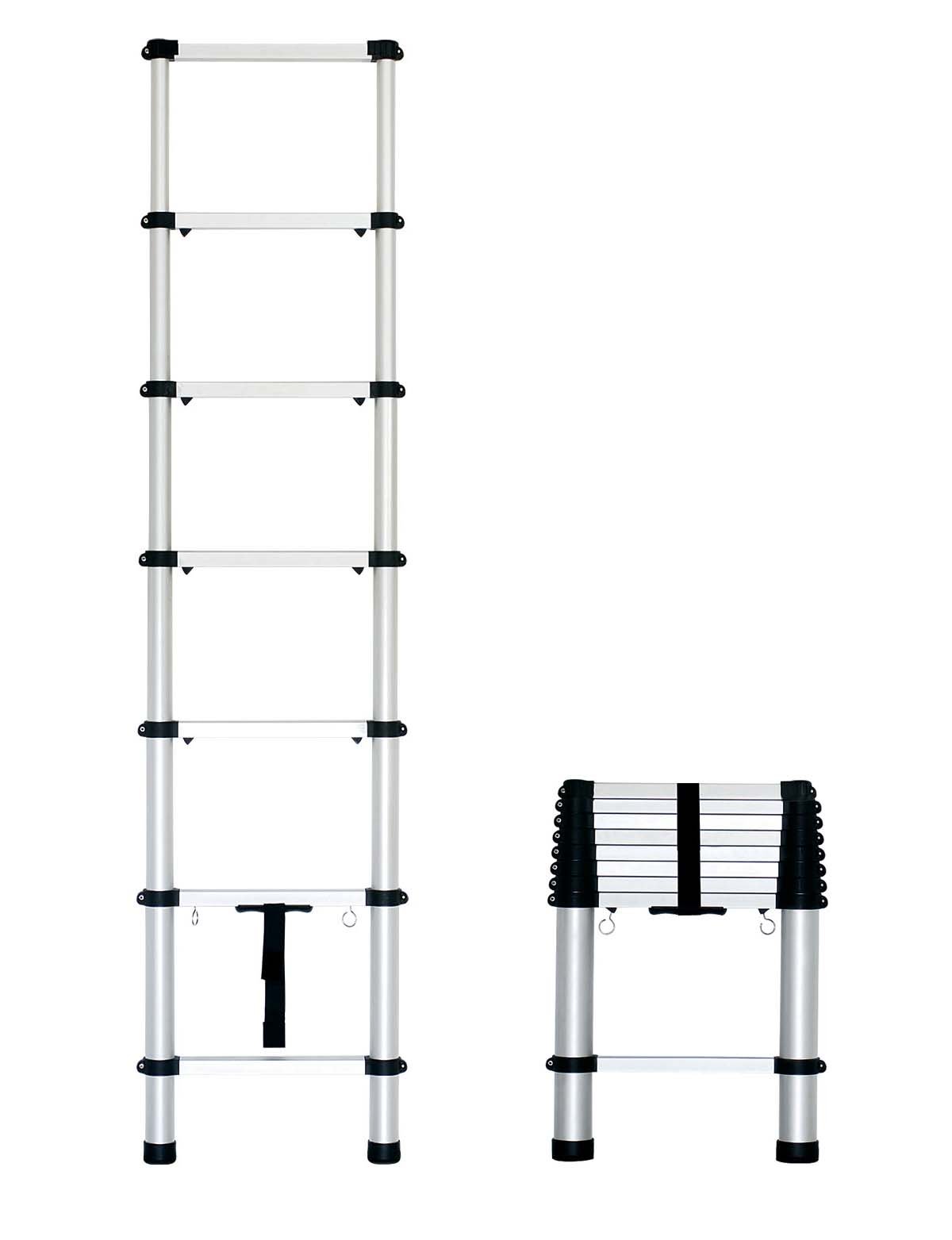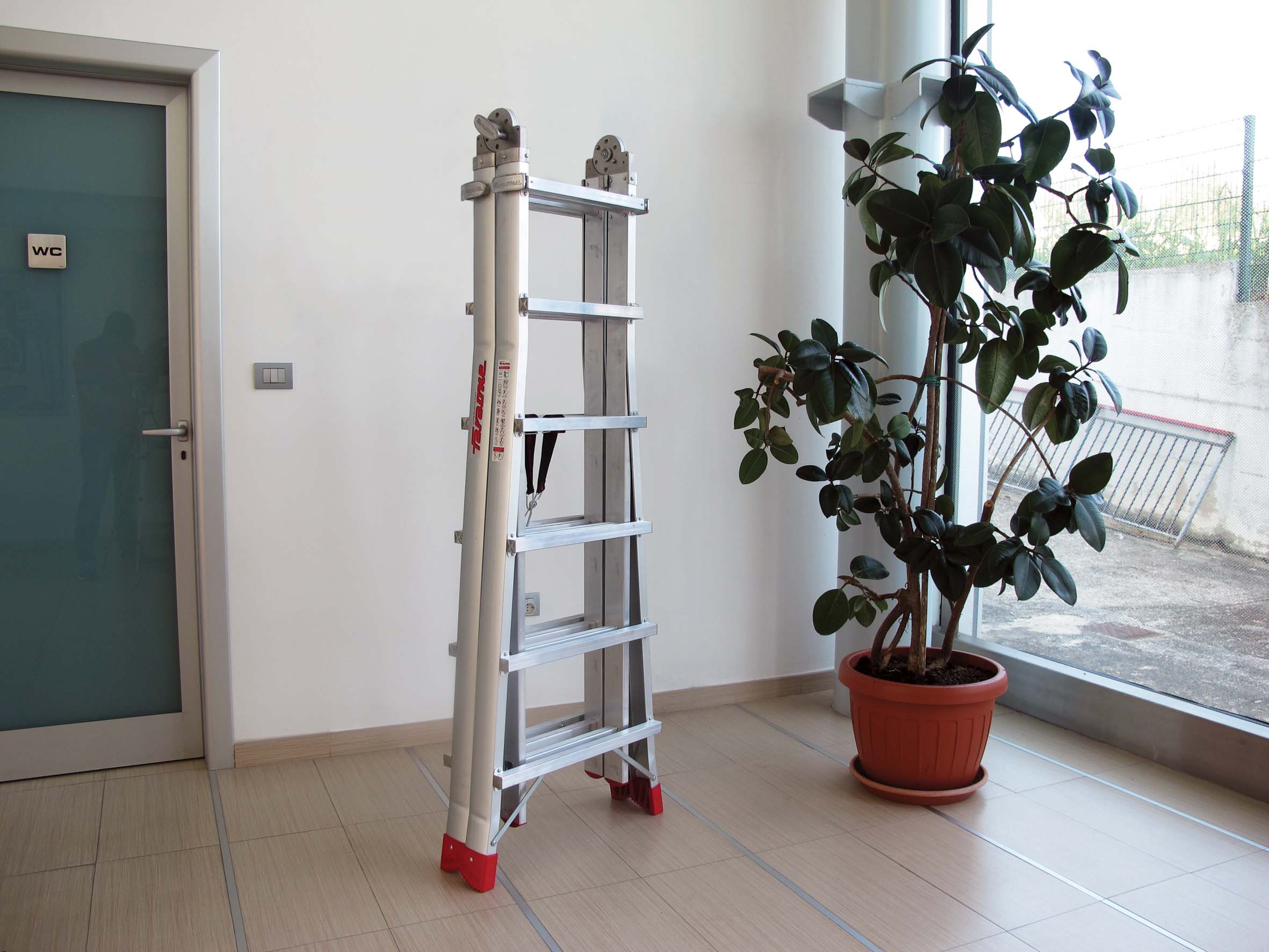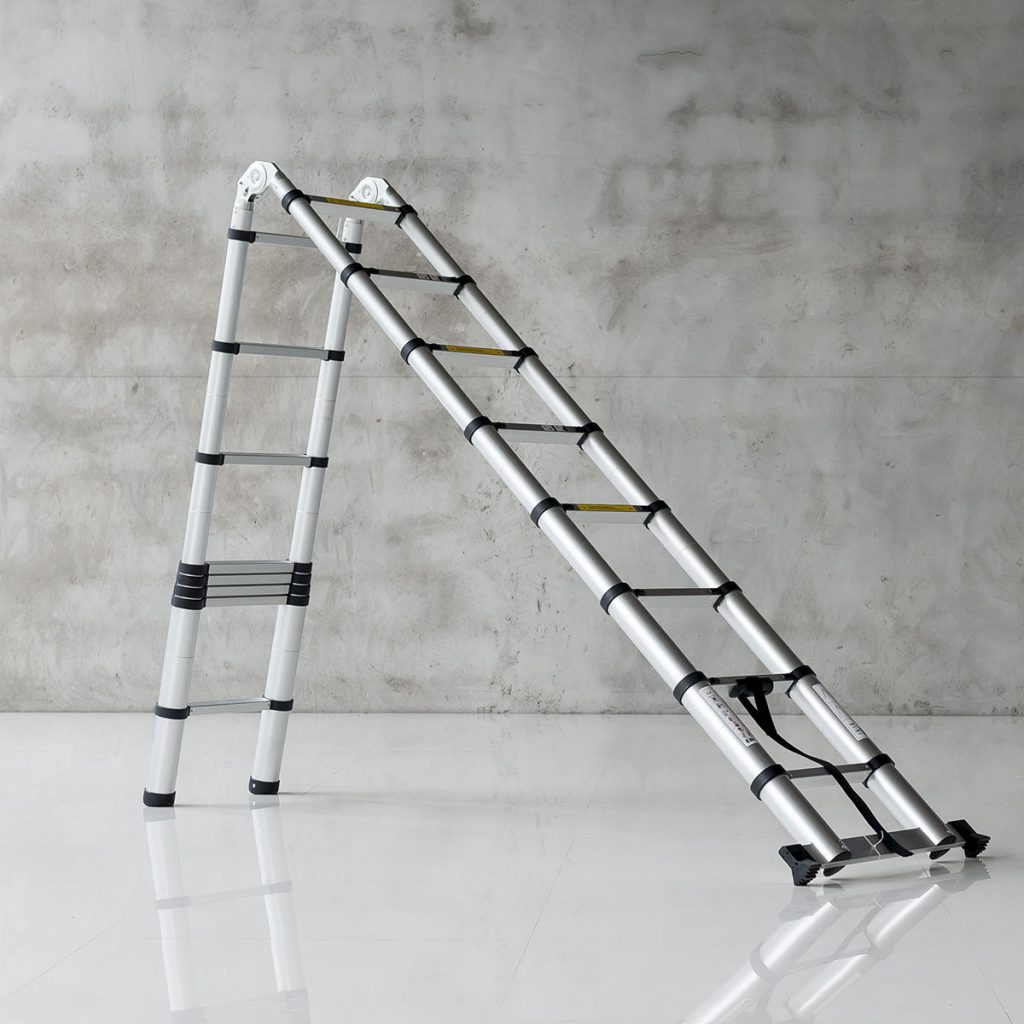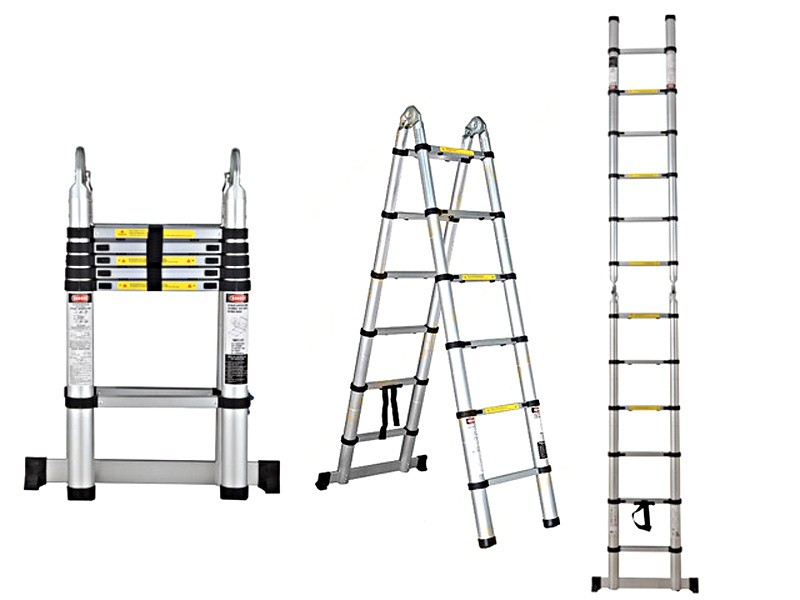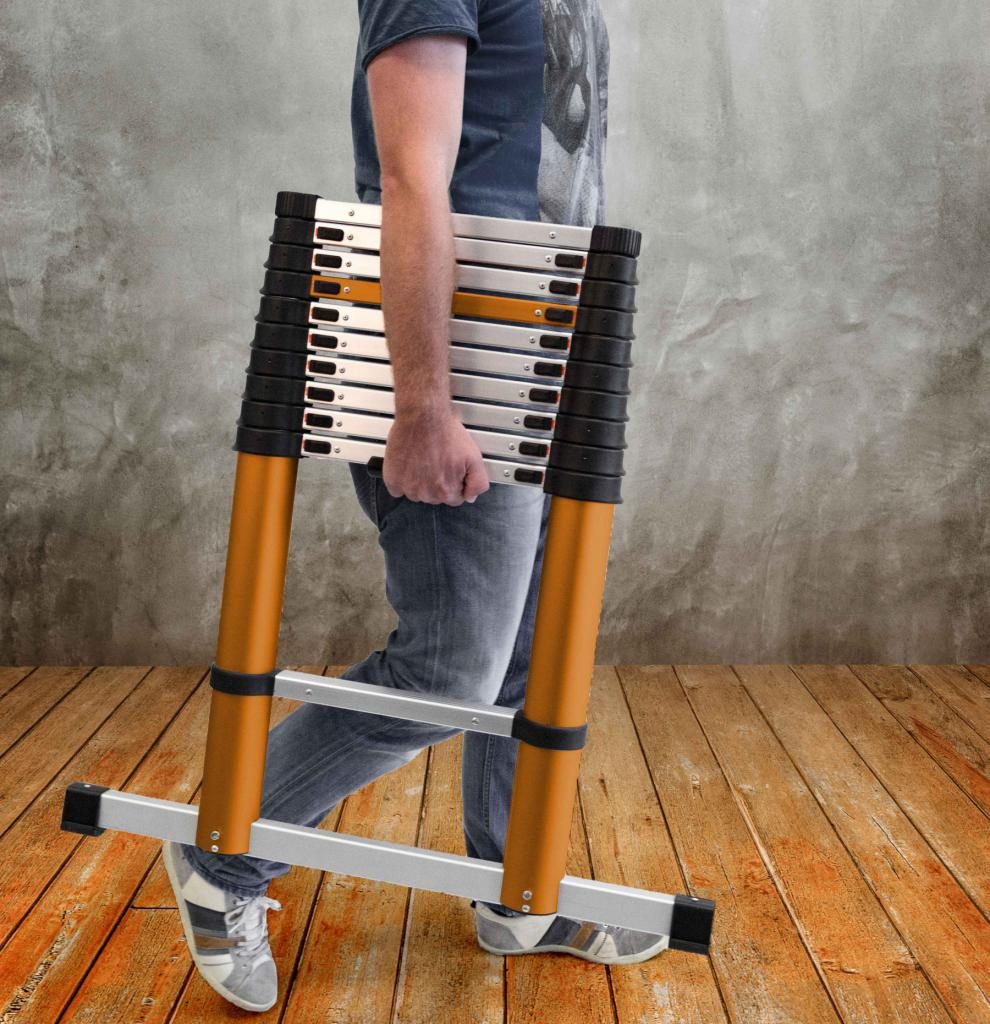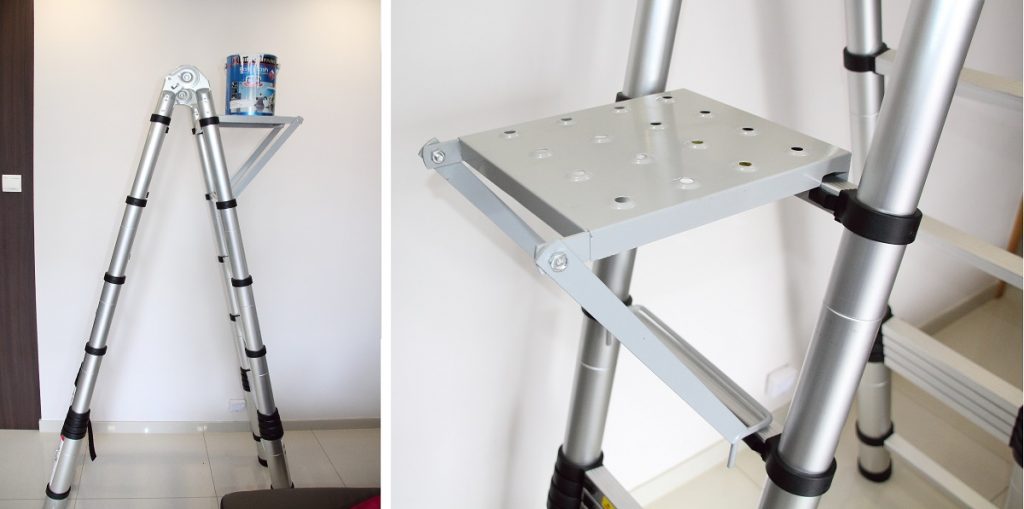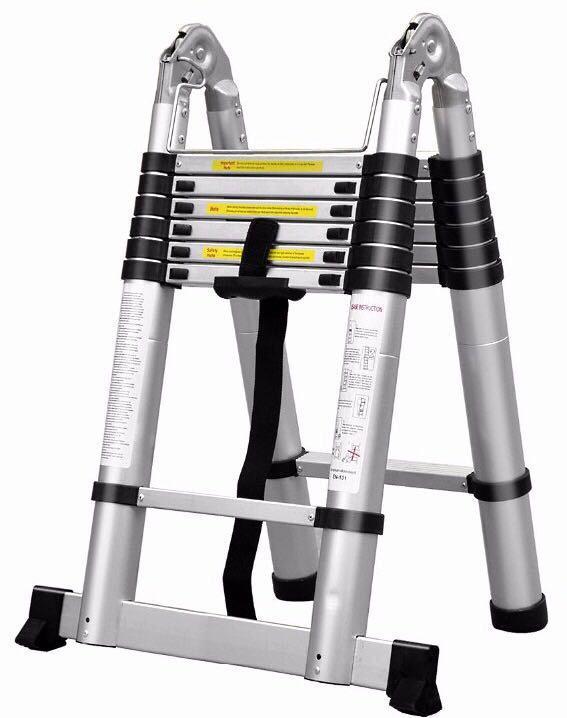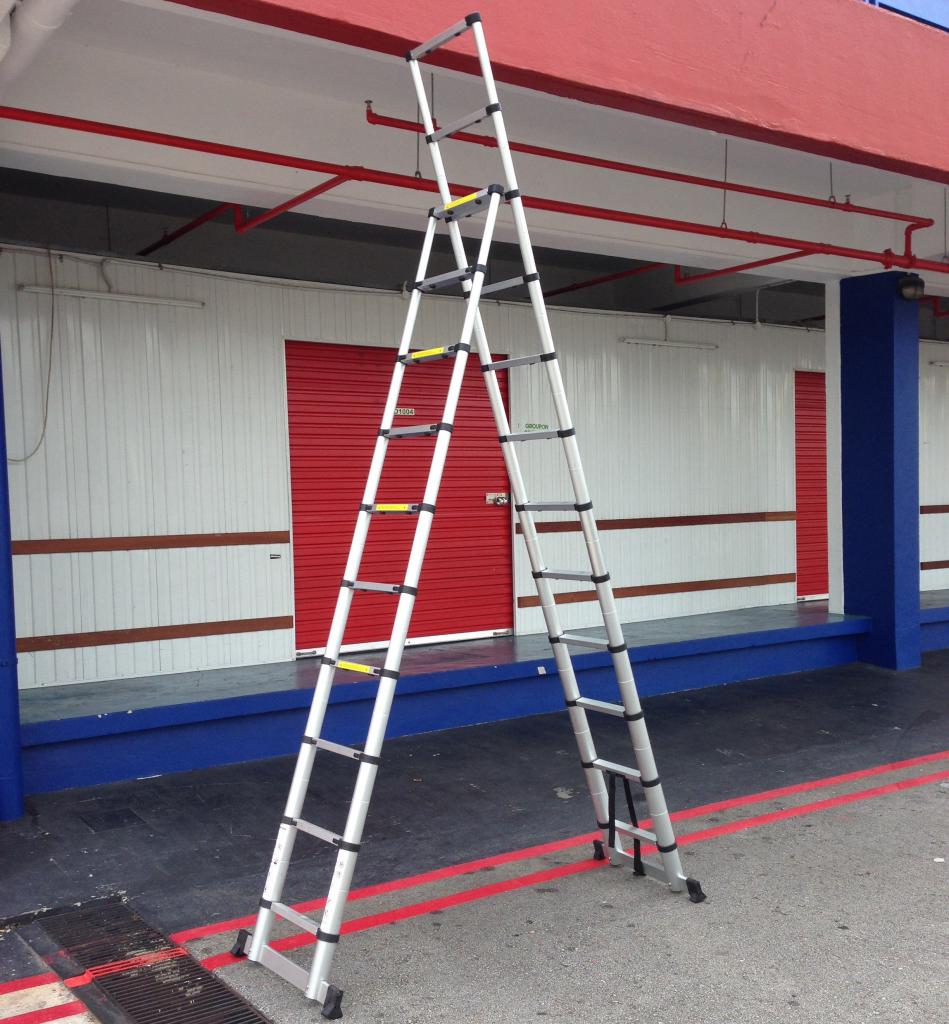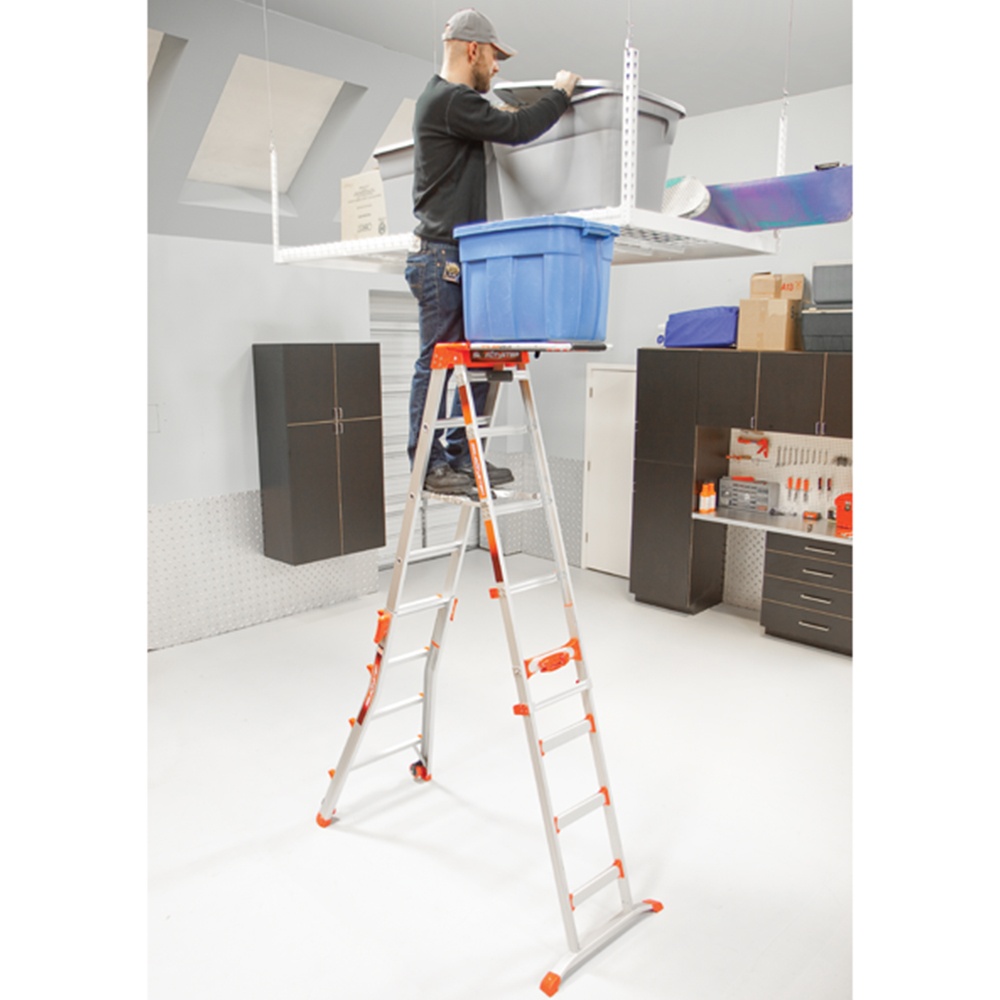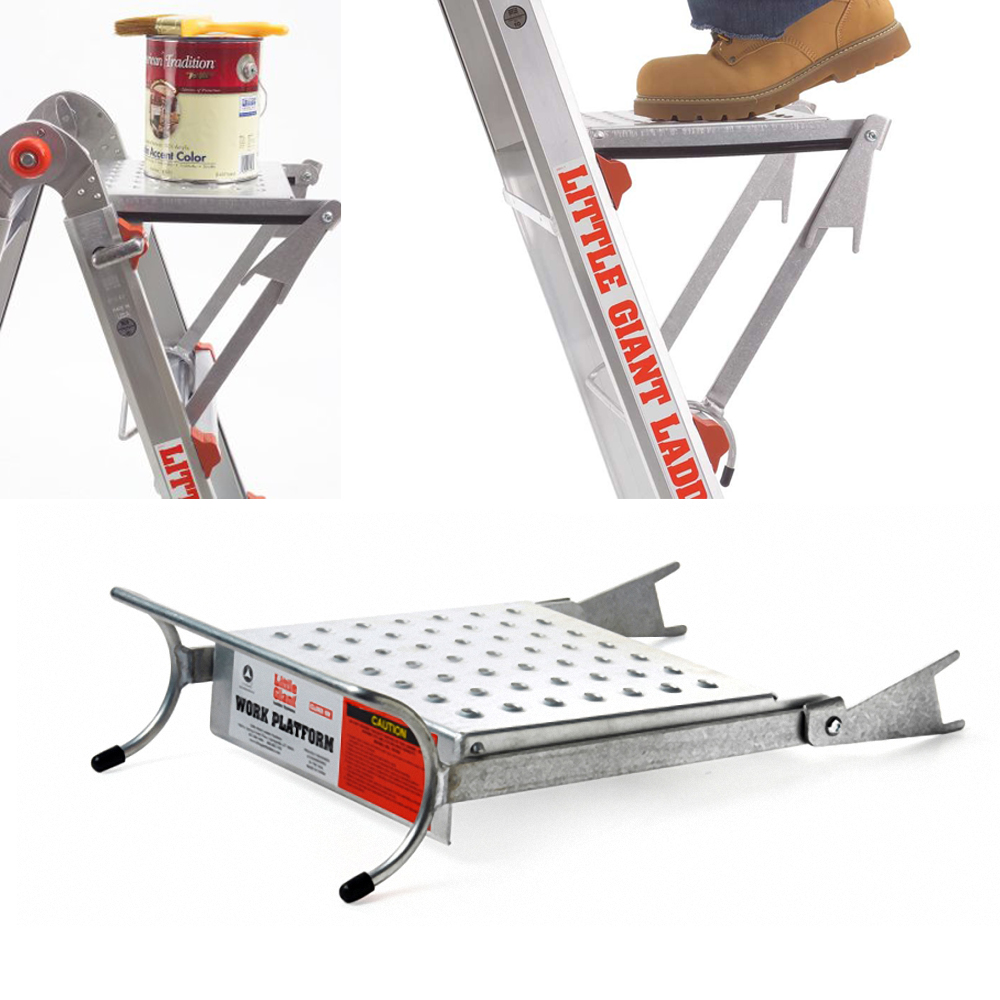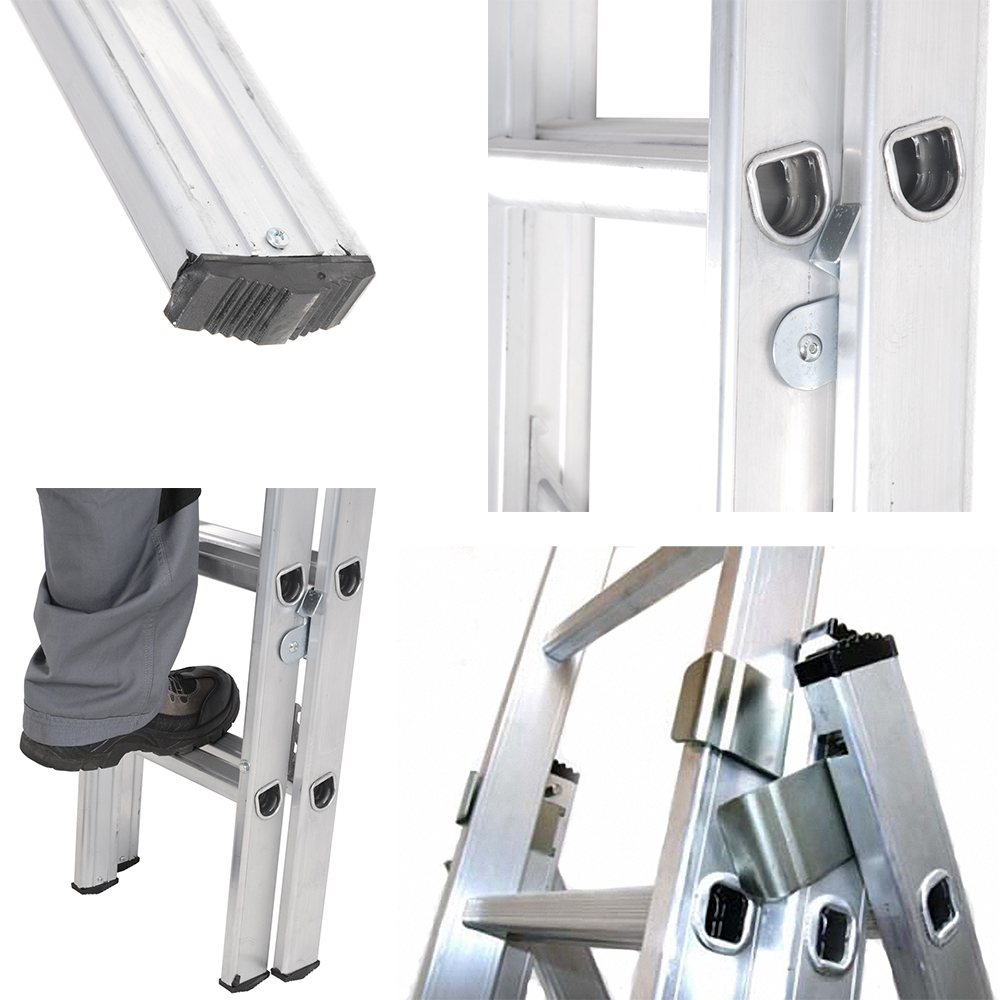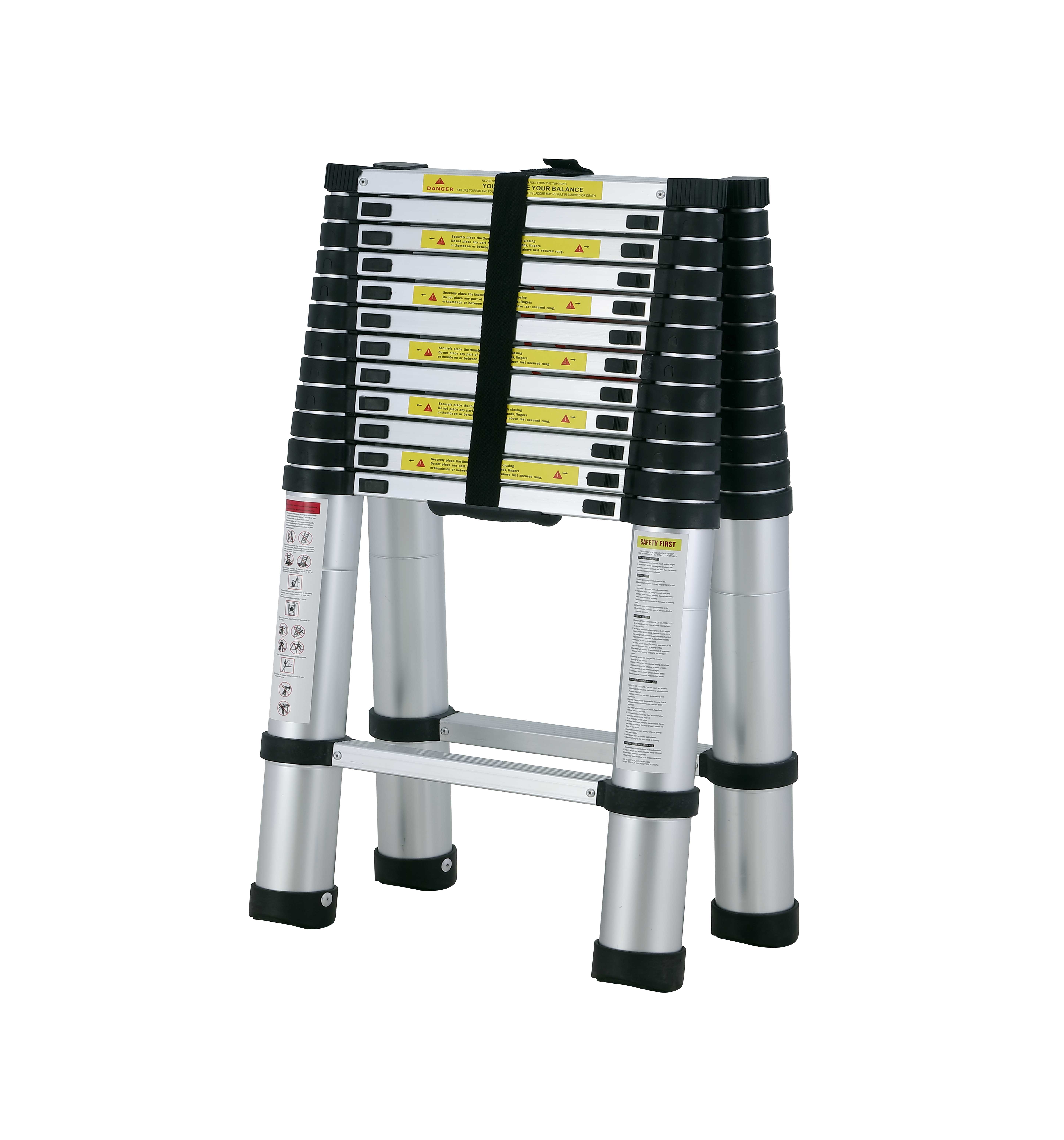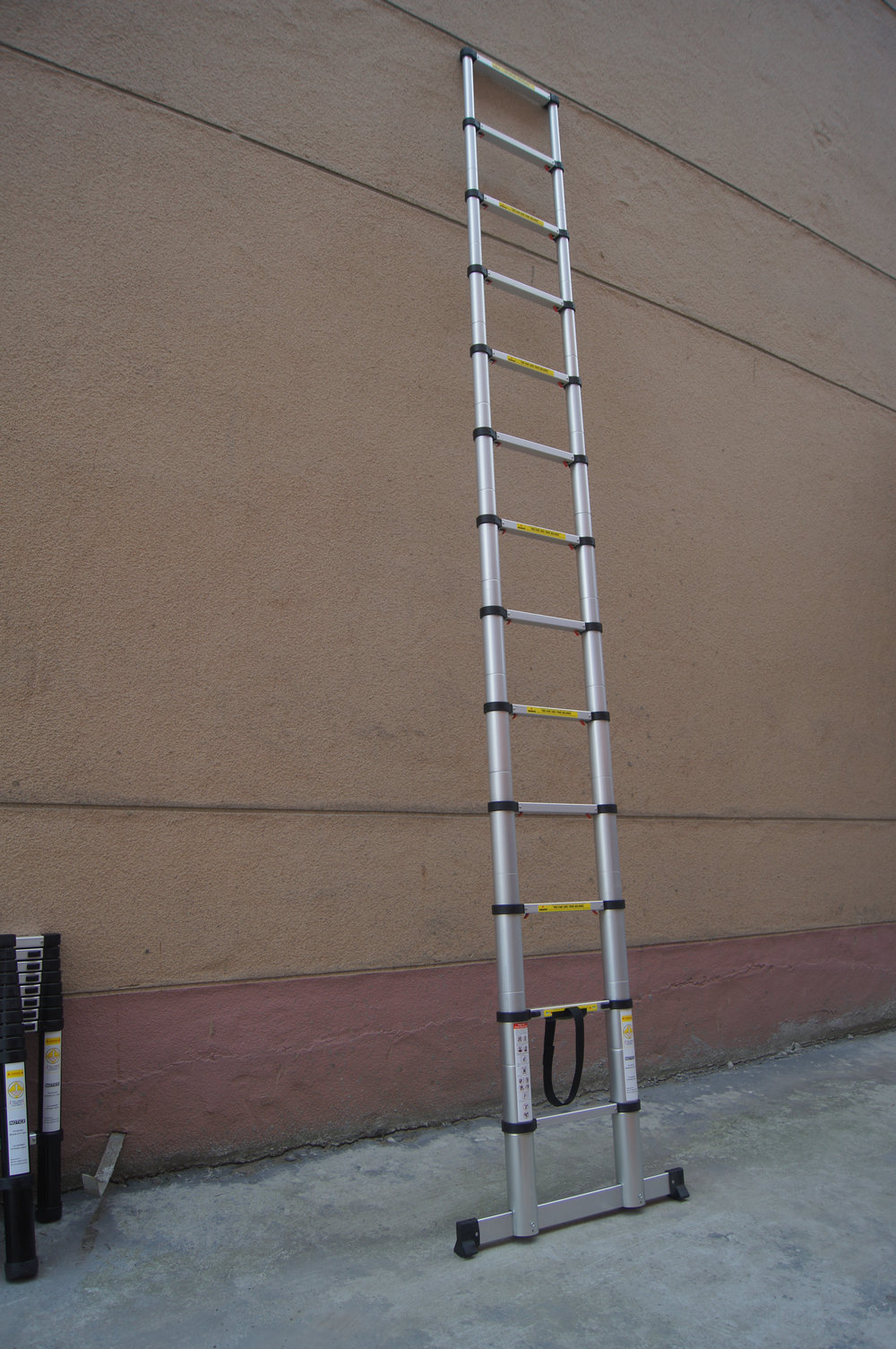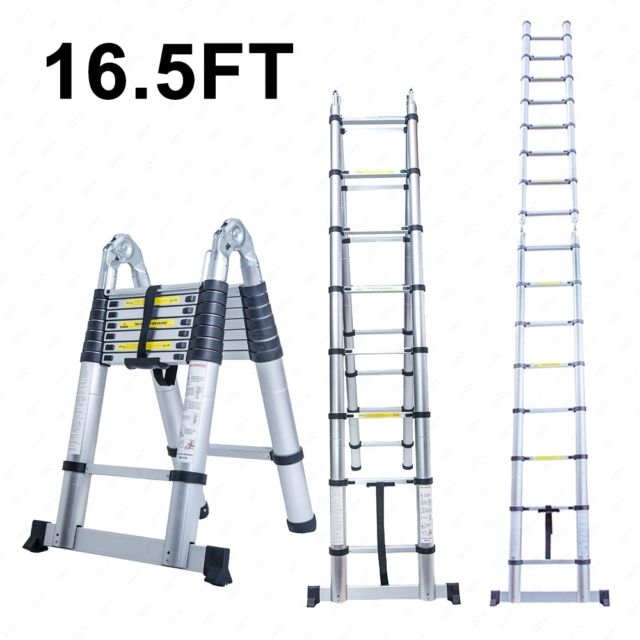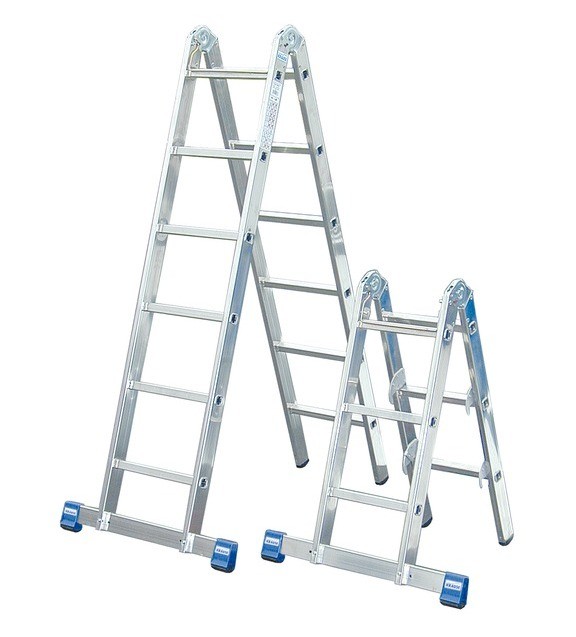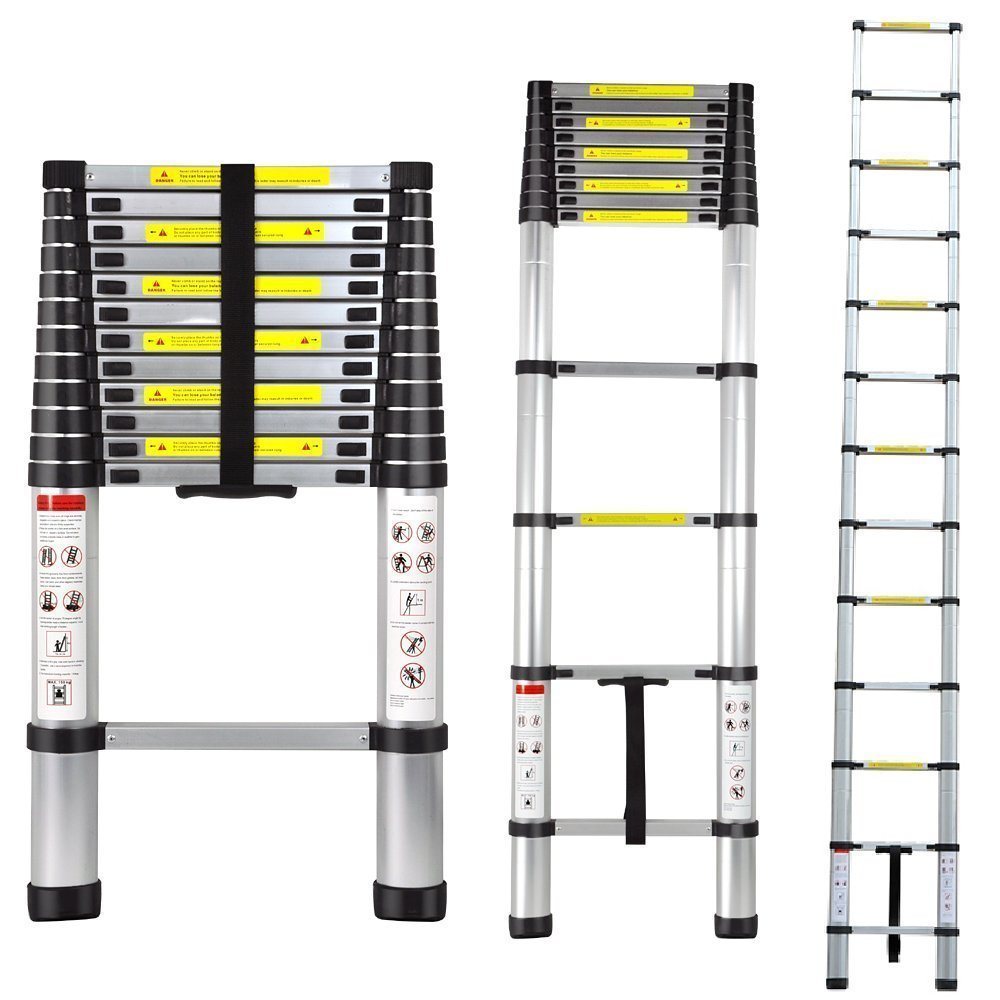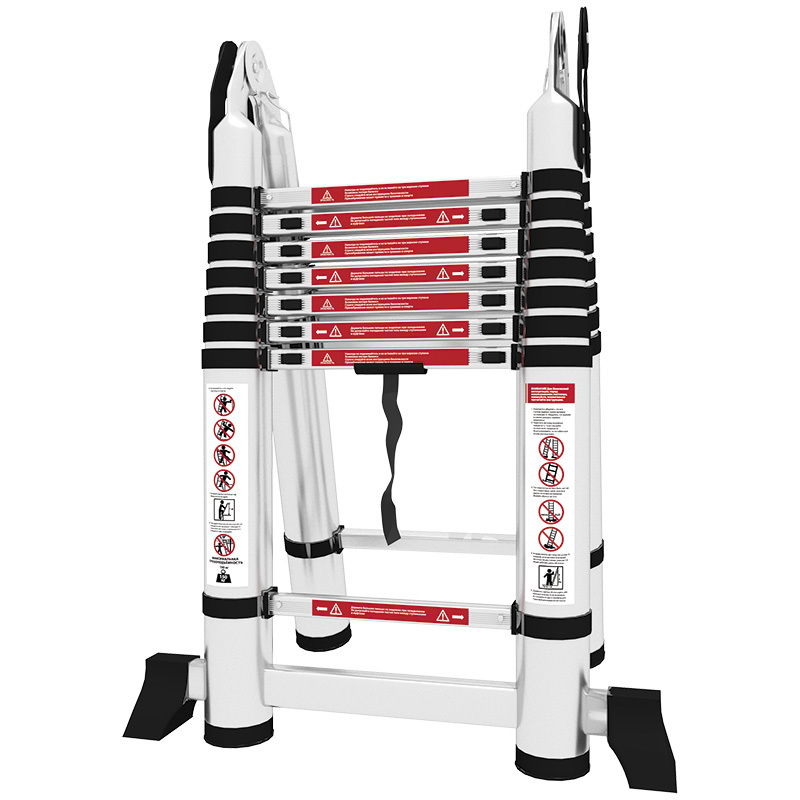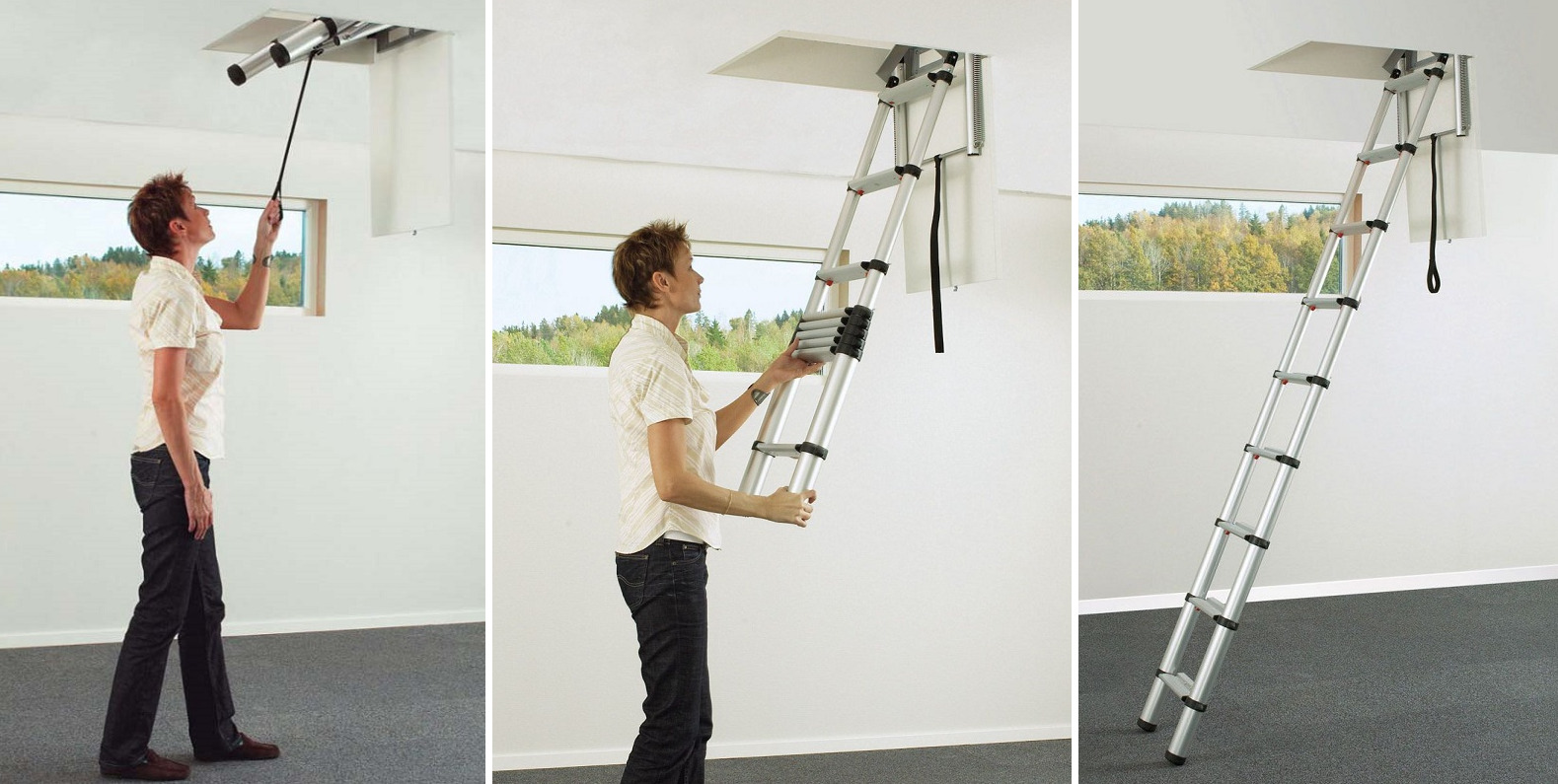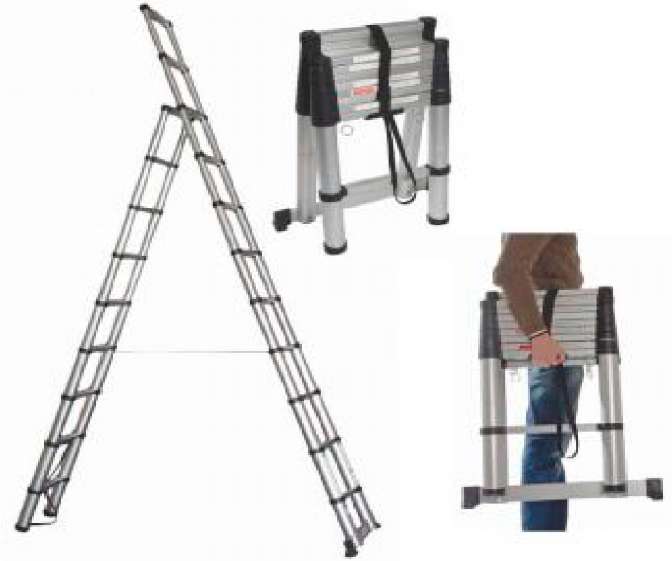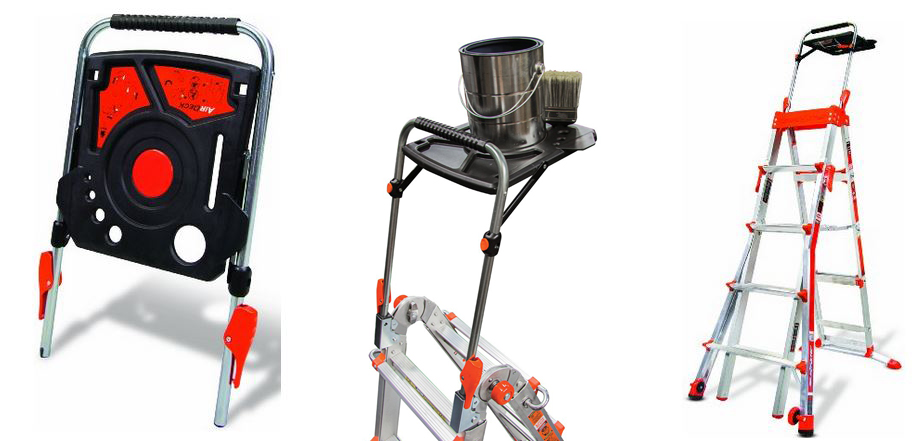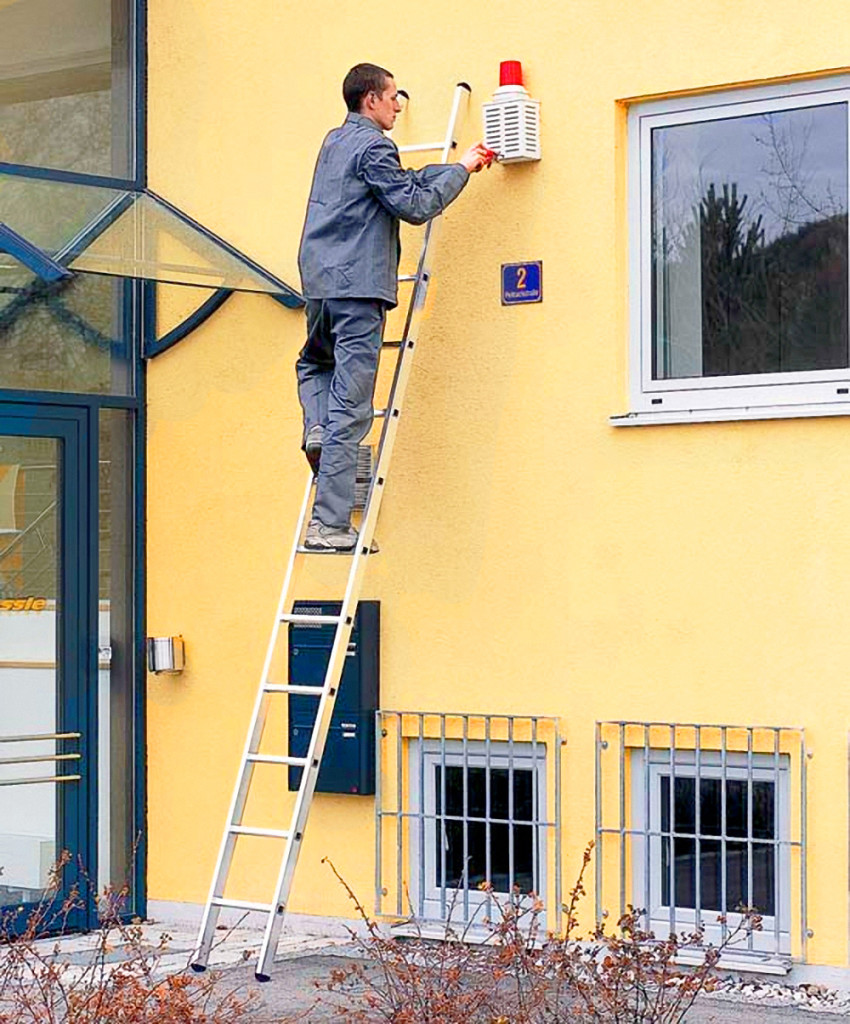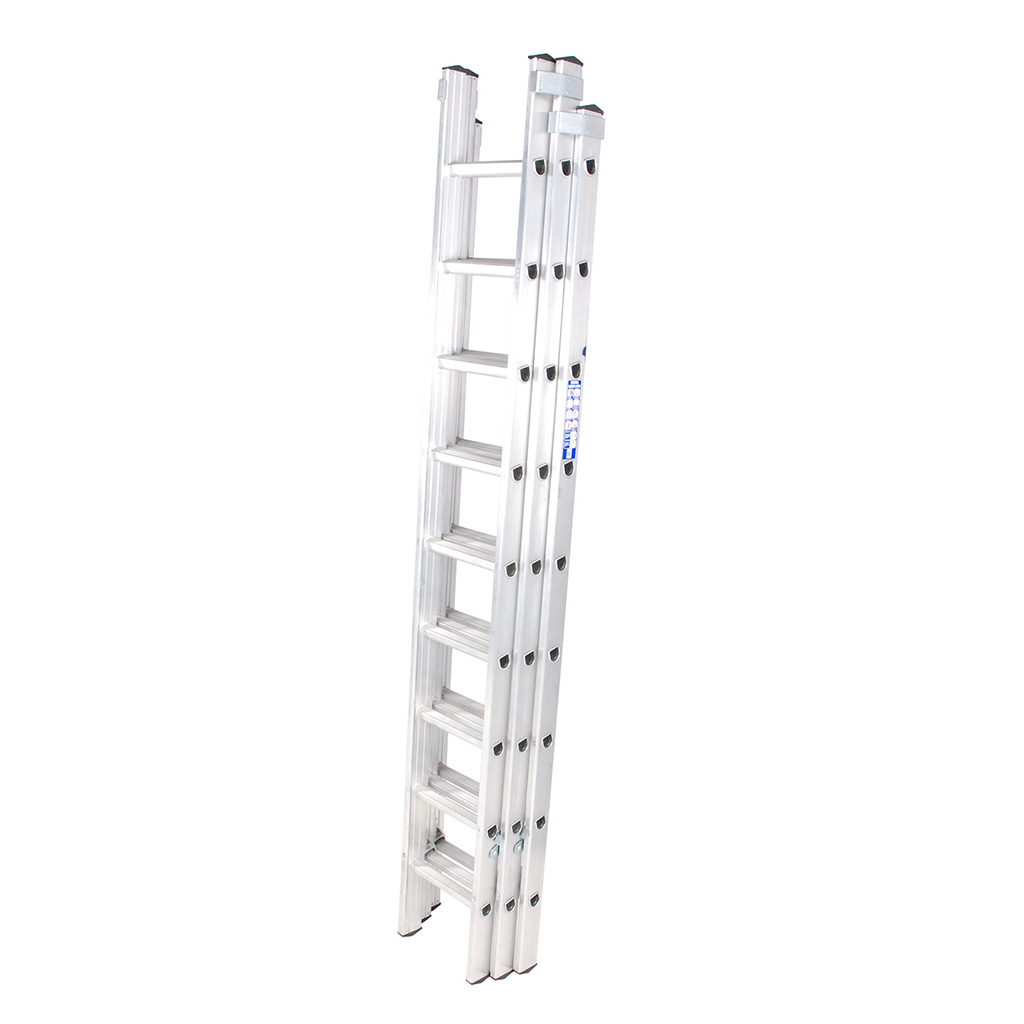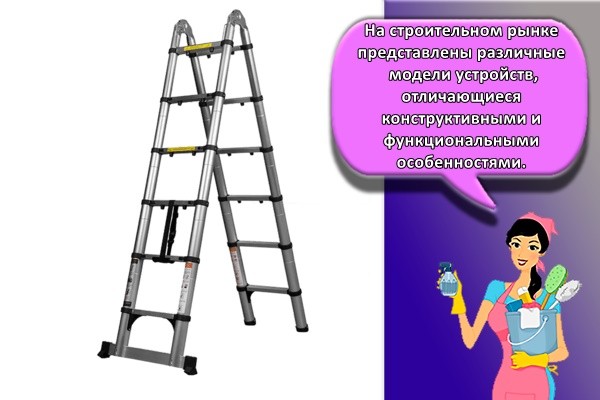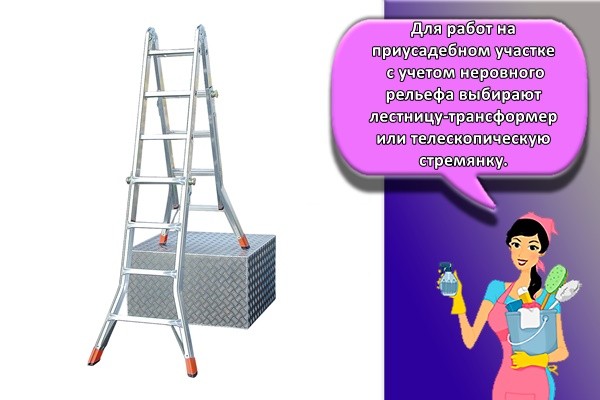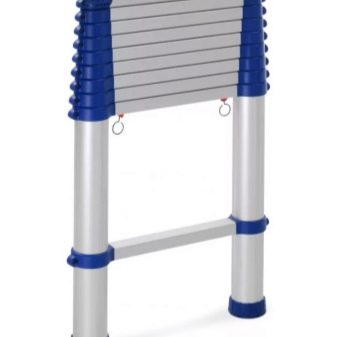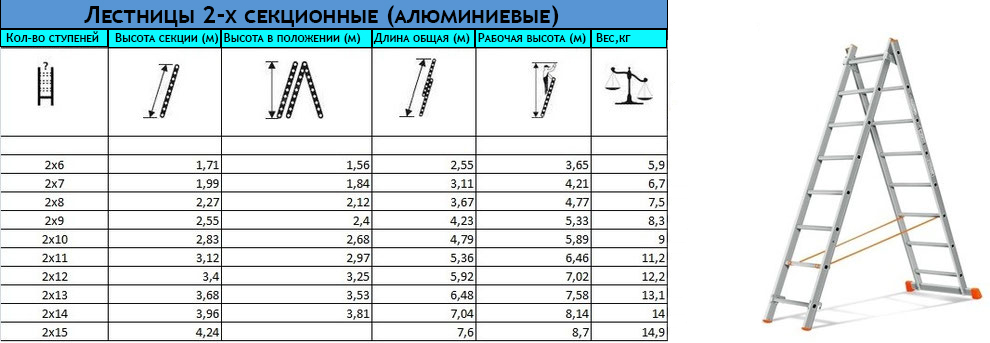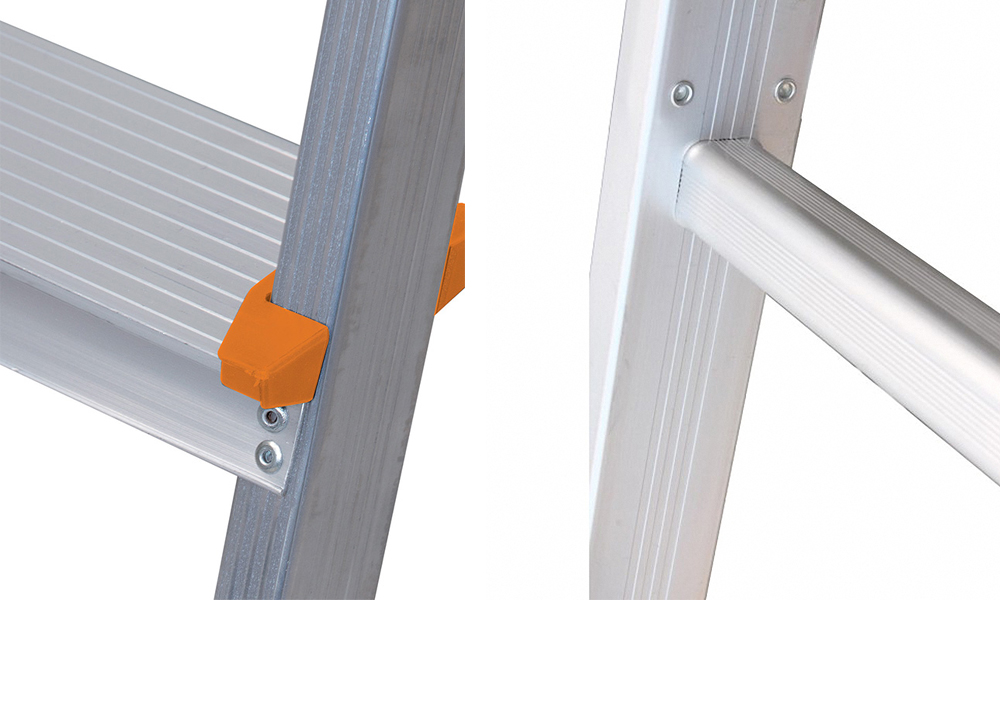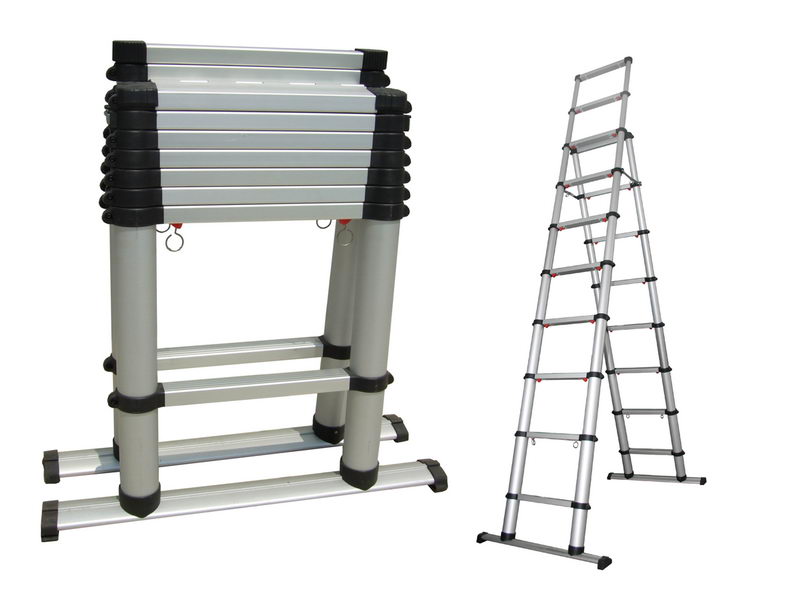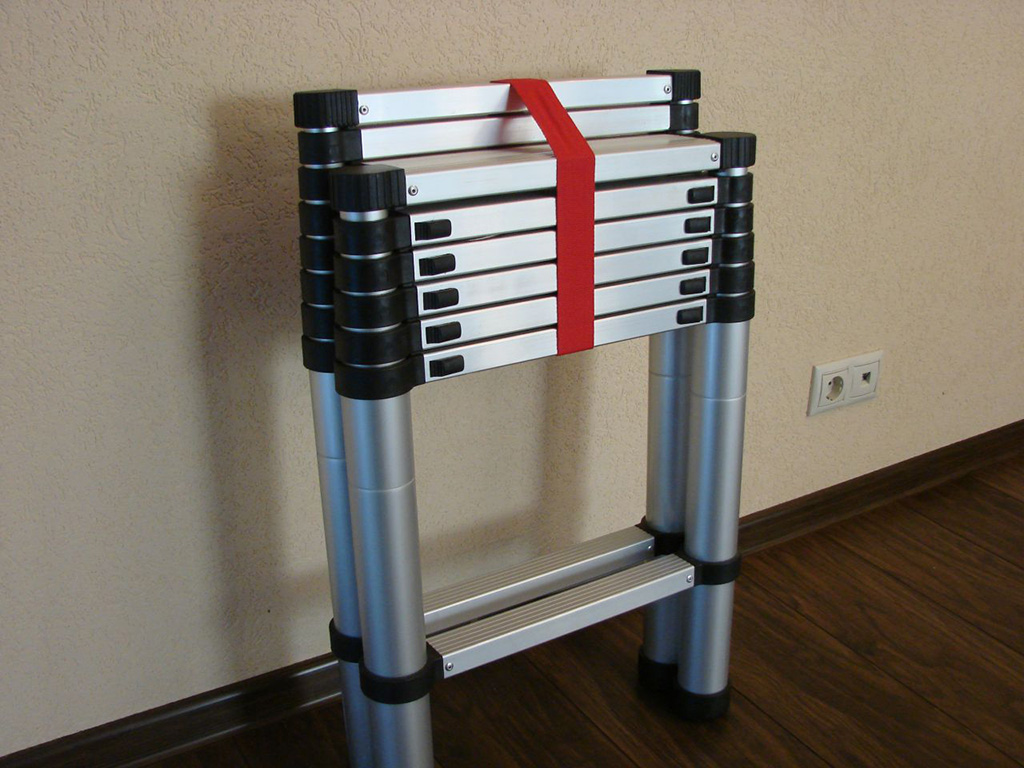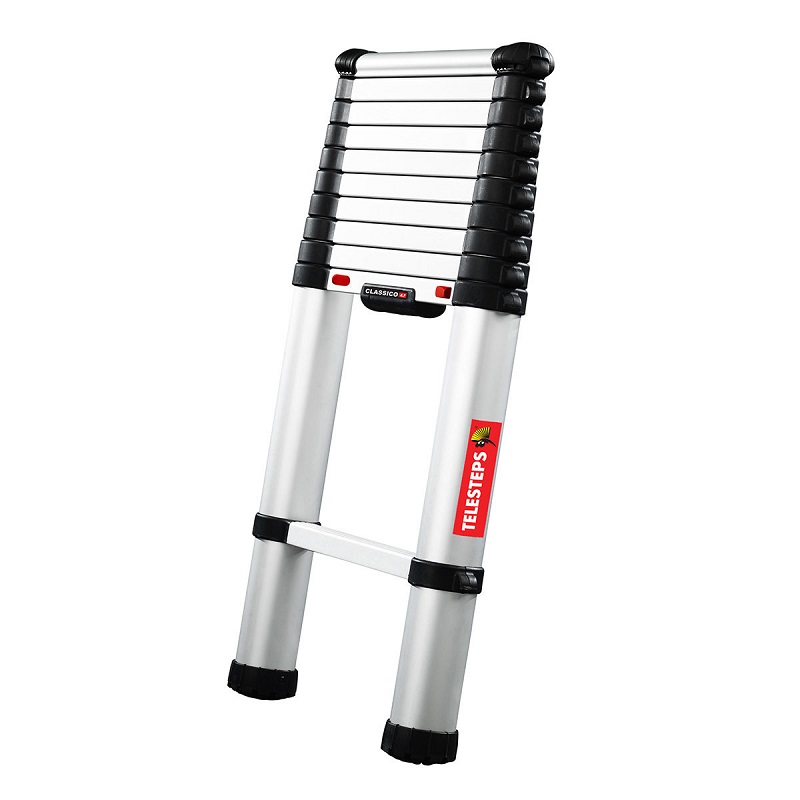Models by manufacturer
Telescopic aluminum products are of high quality, long service life, reliability of connecting elements. An extensive range of stairs is driven by consumer demand for goods. The most popular are products manufactured by Shtok, Kirk, Centaure TT.
Shtok
Shtok stairs were the first to supply the Russian market of household goods. Compact and practical Stem models are distinguished by their low weight, high-quality connecting mechanisms, ease of installation and dismantling.
The manufacturer produces three types of stairs, different in height and design features:
Telescopic ladder (height 1.9-3.8 m).
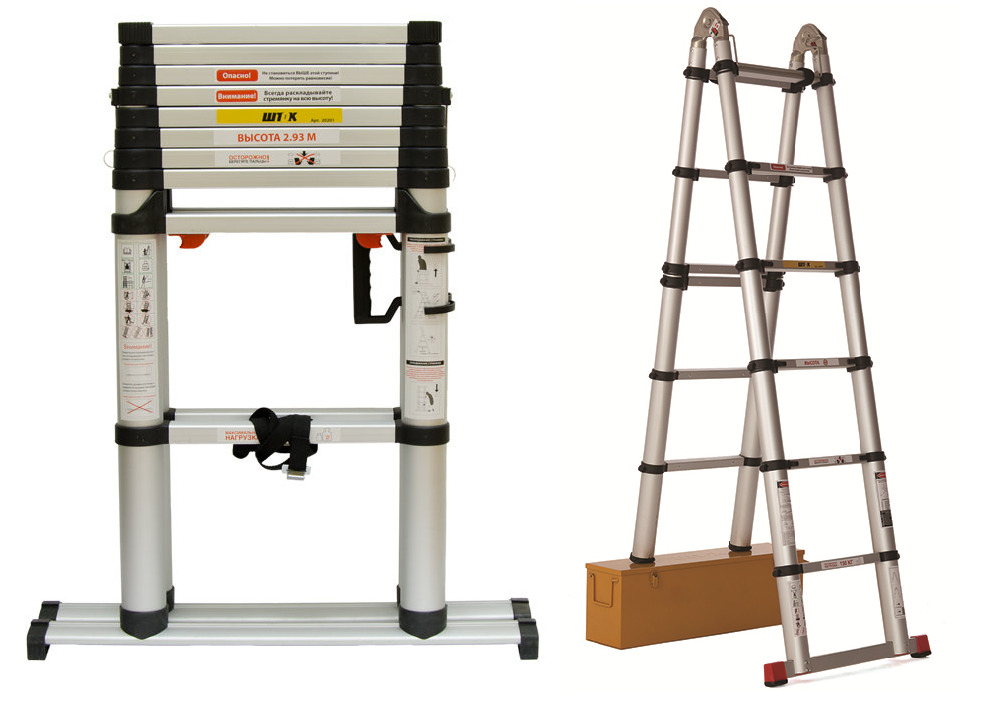
Extendable telescopic model (height 4.1 m).

New folding ladder "Military" (height 2.44 and 3.66 m).

In the video: Military folding ladder in a backpack.
Advantages of Shtok products:
- small dimensions, modern connecting mechanisms;
- simple unfolding to the required working height;
- minimum space for storing, transporting stairs;
- material quality - aluminum profile, silumin tubes;
- plastic fasteners are made from primary polymer raw materials;
- strict observance of the distance between the mounting holes;
- permissible working load - 150 kg, test load - 300 kg.
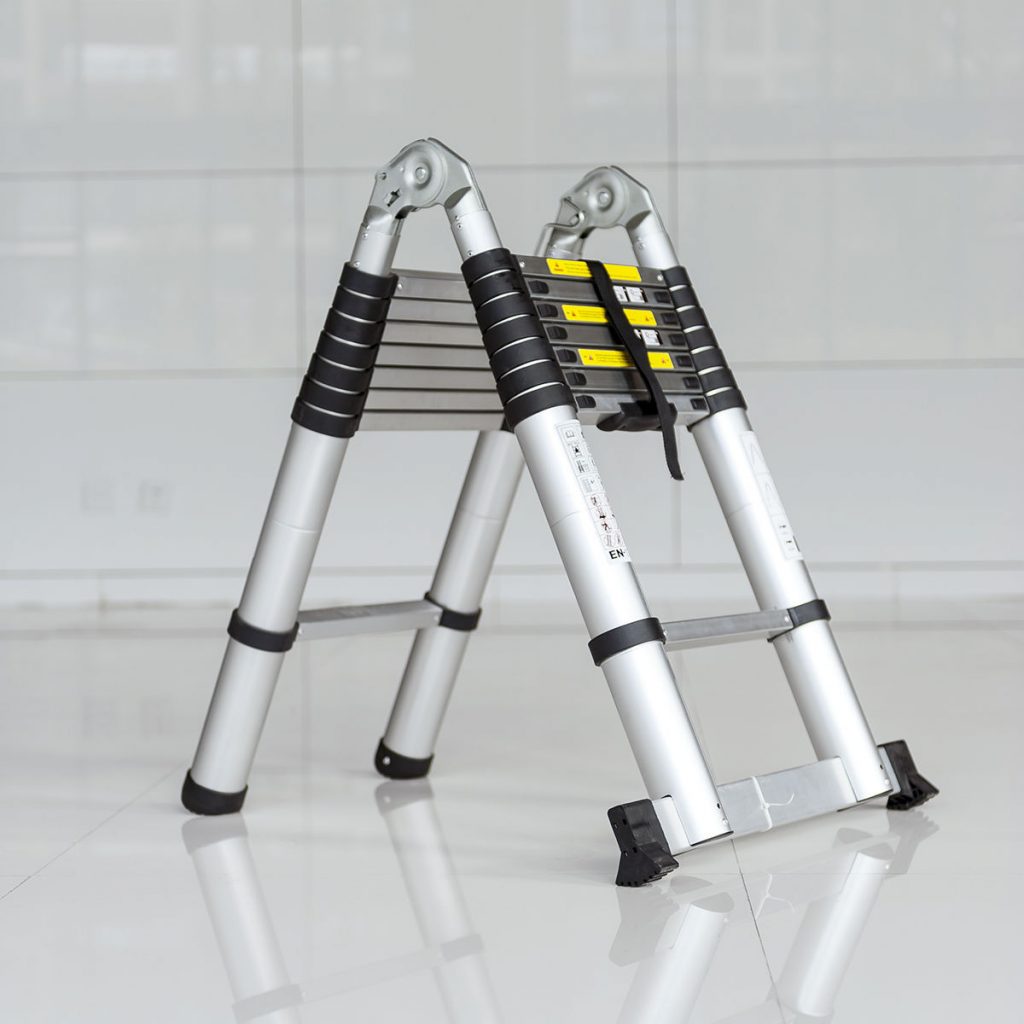
For the manufacture of telescopic products, Shtok uses its own production facilities. Each stage of the process is strictly controlled, all batches of products are tested for structural strength, withstand load. Many domestic consumers trust the Shtok manufacturer.
Kirk
Kirk designs are in demand among domestic consumers. The manufacturer offers a good range of models, among which you can choose any product.
The most popular are the following types of stairs from Kirk:
Transformer (height 3.700, 4.700, 5.700 meters) with two-way ascent, made of aluminum. The number of steps - 12, 16 and 20 pcs.

Stepladder (height 1.480, 1.650, 1.830 meters) equipped with an upper platform. The stepladder is made of aluminum, equipped with a different number of steps - 5, 6, 7 pcs.
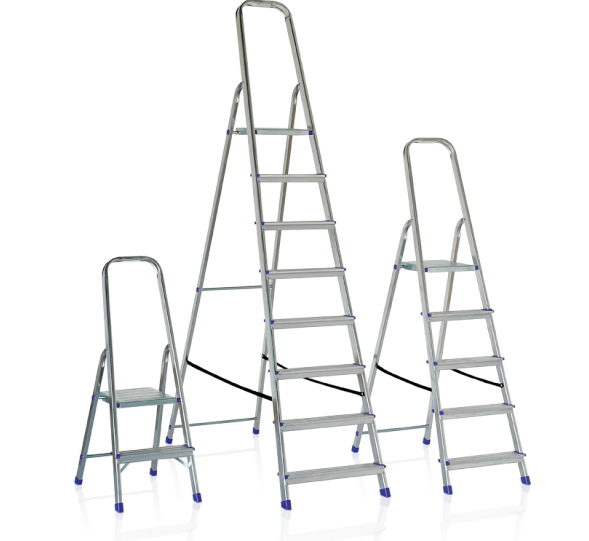
Stepladder (height 5.670, 8.800 meters) of two-way type of ascent. The product is equipped with a large number of steps - 24, 36 pcs.

Kirk products are designed for household and industrial use, have a compact size and minimal weight, do not require much space for storage and transportation.

Centaure tt

The devices of the French manufacturer Centaure of the TT type have the following characteristics:
- Universal use of a four-section structure in the form of attachments, stepladders with a height difference;
- Each section contains 4 pieces. degrees, product weight is 12 kg, transport size is 1.24 m;
- The working height is 2.1 m, and the total length of the ladders is 4.1 meters, the load reaches 150 kg.
Centaure TT ladders are characterized by a secure installation, with three automatic snap positions. An optional accessory is non-slip composite shoes. The height adjustment of the structure is carried out in stages.
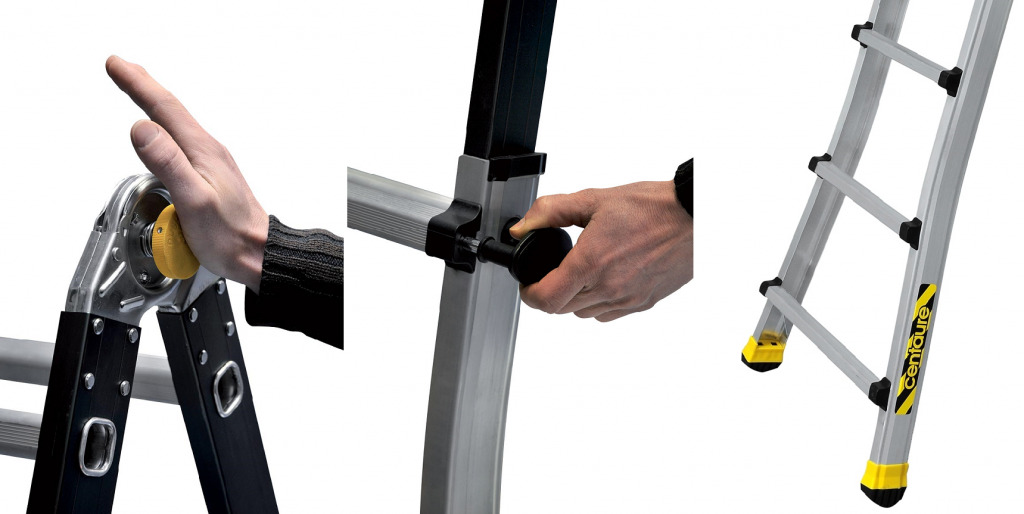
Professional models of Centaure TT stairs are suitable for installation, electrical installation, communication work, providing comfortable access to serviced objects located at different heights.

Various telescopic designs can be selected from the catalog online.To sort the models according to the required parameters, you can use the proposed search filter. Before sending goods to the cart, you should enter the promotional code and make a free call to the company representative to clarify the availability of the required telescopic ladder, model characteristics, payment methods and delivery terms.
Main types
There are the following types of stairs: main and auxiliary. Most often, the structure is used for unhindered movement between two floors.
The solution to the question of how to choose a ladder directly depends on the key characteristics of the connection. For example, the installation will be radically different when going up to the attic or the second floor. The types of stairs by design should be chosen depending on the purpose.
Marching
Marching structures - a straight ascent, on which spans with platforms can be installed. They carry more weight, therefore they are used to connect basement floors. It is also allowed to rotate the march, if such a design is provided by the owners of the house. The use of stringers or bowstrings is necessary for the purpose of creating marches. A concrete or timber beam will provide the required level of strength.
The marching type of stairs has a number of advantages:
- Ease of assembly and a wide selection of materials that can be used to create a structure.
- Attractive appearance. The steps can be designed in any style that fits into the design of the room.
- The lift can be supplemented with a swivel element.
- Possibility of creating closed riser walls.
Read next: how to make a two-flight staircase?
Rotary structures
In the process of choosing a design option, it is necessary to take into account the type and quadrature of the room. Pivoting staircases are often used in combination with studio apartments. A sleeping place is located on the second floor. The types of stairs to the second floor can be very diverse. For example, they are often made in high-tech or postmodern style. Thanks to this, it is possible to significantly save space.
Which ladder is better can only be determined by the user after analyzing the needs and features of operation. The combination of wood and metal looks unusual and impressive. Concrete lifts will also need to be supplemented with various decorative elements. Swivel stair types have the following advantages:
- Lifts of this type of stairs can be used in any premises for their intended purpose.
- Large selection of materials and designs.
- Will be a great addition to any design.
The structure must be at least 0.8 meters wide. Thanks to this, it is possible to significantly save space and harmoniously decorate the interior. If in doubt, then the consultation of a specialist in this field will help to decide which staircase is better.
Winder steps in swivel staircases
Safety requirements for the design of steps on all lifts are the same. Winder steps with 90 degree rotation help to significantly save space. Unfortunately, it is impossible to install ramps for disabled people on them. That is why the construction can only be used at home.
 Each type of ladder has its own nuances.
Each type of ladder has its own nuances.
Design can be made unique. Thanks to this, it will become a real decoration of any interior. The space under the stairs can be left open. This will significantly expand the visual room. Straight flight stairs are significantly inferior to this option in terms of appearance. The first option can become a real highlight of the interior of any room.
Experts consider the best option to be a structure that can be rotated 90 degrees. During its operation, the likelihood of injury is minimized. It is convenient to climb by design. It leaves enough room for movement. It is considered ideal for the home where children live.
Read more: how to make a staircase with winders?
Screw or spiral
Screw, cruise structures are formed around the base. They allow you to conveniently and practically connect several levels of a building at once. Key elements of the staircase:
- Central (axial) part.
- Steps.
- One of the parts of the structure must be attached to the load-bearing wall. It becomes a support for every step.
- Correctly selected bowstring gives rigidity to the structure.
The lift can be made of metal, concrete, stone, wood, glass. There are many combination options that will complement any room's interior. It is necessary to figure out what is called bowstrings. Stability also depends on other parameters.
This is interesting: everything about spiral staircases.
Popular questions and myths
There are many different questions about stairs, but the answers are often veiled in myths. There are several questions, the correct answers to which are known only to a few. Several popular questions:
The load on the ladders is very high, what will happen to the smooth surface after work? After all, she will scratch her.
 Protection of the surface from damage by ladders
Protection of the surface from damage by ladders
At the base of the ladder there are protective plastic caps that not only protect the work surface from scratches and damage, but also prevent slipping. These caps also protect the ladder from dirt from entering the aluminum base.
The worker's weight can be large, plus the equipment needed for the job. Will the ladder break under such a load?
Ladders of this kind can withstand a load of 150 kg, so an employee weighing even 100 kg has nothing to worry about. And the inventory can be easily placed in a special tool tray. Such a compact tray will only increase the speed of work and will not distract the worker.
Can a sliding ladder be dangerous if the surface is uneven?
Modern ladders are constantly being improved to improve their reliability.
Ladders of this kind are reliable in use, multifunctional and take up a minimum of space when folded. Therefore, with all these advantages, they are gaining more and more popularity.
Attachment selection criteria
All telescopic ladders are very versatile. However, before making the final decision on buying a particular model, you need to clearly understand for yourself some important points:
What is the maximum working height required for the planned work. For example, a 5 meter ladder can be extended to a length of 2 or 4 meters. Such a device should be purchased if it will be necessary to use it both indoors and outdoors. If you do not plan to work in a standard room, then a 3-meter long telescopic ladder is quite suitable. There is no point in overpaying for extra meters. The width of the steps. In order to hang a picture on the wall or climb to the country attic, a product with narrow steps is quite suitable. But for the production of repair or installation work (rather long in time), it is better to choose a device with wider leg rests. The presence of a transport bag, which some manufacturers offer as an option. If work is carried out regularly and at various facilities, then the purchase of such an additional accessory is economically justified. Well, if, after use, the ladder goes to storage in the pantry, then you should not spend extra money. Automatic unfolding / folding system. The presence of such a device significantly increases the cost of the product. There is no point in acquiring such expensive devices for use at home.But for an electrician who daily serves, for example, the lighting fixtures of a large enterprise or a large shopping center, the presence of an automatic staircase will help to significantly reduce the time of work
It is also worth paying attention to how well the manufacturer of the selected model has proven itself and how long it has been in the manufacture of such stairs, as well as the presence of an appropriate safety certificate
What features need to be considered
Each type of staircase has its own specific nuances and features. The inconvenience of spiral staircases dictates their installation as additional structures for lifting to another level, attic or descending into the basement.
If there is too little space for the stairs or the opening in the ceiling cannot be made of a sufficient size, then the angle of inclination of the stairs relative to the horizontal surface can be increased. In this case, the installation of steps, called "duck step" is provided.

A staircase without risers will look easier, but if there are kids in the house or their appearance is planned in the future, then it will be better to make the steps deaf.
In fact, there are many options for making a comfortable and safe staircase structure. It all depends on the specific room and people living in the house. And if the owner is confused and doubts the chosen design, then it is better to consult with knowledgeable specialists.
Professional and household models
Now let's start choosing a suitable transforming ladder
The first step is to decide for what purposes it is needed: professional or economic (household). Professional models are significantly more expensive and hardly need to overpay for them if they are used rarely, not intensively and only for light work
Ladder-transformer 4-section professional
Here are a few signs by which it is easy to distinguish a professional model from a household one.
- Price. As is the case with any other professional and household equipment, it is better to compare prices within the products of one brand (brands will be discussed a little below). It is likely that a "professional" Chinese transforming staircase will cost less than a "household" European or American one.
- Materials. Professional models are often made of steel, fiberglass, or a combination of steel and aluminum.
-
Maximum permissible stage load. For professional models, it should not be less than 150 kg. For household models, a value of 100-150 kg is allowed.
- Profile wall thickness. For metal models, the thickness of the steps should be 1 mm for steel and 1.5 mm for aluminum.
- Functionality and equipment. The functionality of professional hinged ladders is often extended with accessories that expand the possibilities of working at height: bucket hooks, organizers and tool holders, painting trays, etc. Solid metal decks, removable work platforms and shelves can be included as standard.
- Number of steps and length when unfolded. As a rule, the number of steps in professional models is higher than four in one section. The length of a fully unfolded staircase sometimes reaches 7–8 m. For domestic purposes, a length of up to 4–6 m is sufficient.
-
Elements of connections. Professional “transformers” use forged elements, while household ones use stamped ones.
Features of the choice of an aluminum ladder
Let us dwell on more significant topics and consider in detail the especially important points, given that the height parameter and the type of stairs have been selected.
1. Appearance and configuration is an important parameter, since the ladder must be chosen for a certain range of tasks and a place of frequent use.For example, an aluminum transforming staircase is not entirely appropriate for an apartment.
A stepladder with a working height (the level of the last step-crossbar) a little more than a meter is ideal for her. But for a country house, on the contrary, a transforming structure will bring more benefits.

Slightly worse is the nut-bolt connection. The downside is the need for periodic monitoring and correction of the required level of tightening of all fasteners.
The most unreliable is the point welded fixation. It is highly undesirable to purchase such a sliding ladder, since this option will not last long and can lead to injuries.
Care
Telescopic ladders are a high-tech product, therefore, when using and storing it, certain rules and regulations must be observed:
- Keeping the tubing clean. After work, you should clean them from possible contamination (paint, glue). Dirt and water must not get inside the tubes. All parts must be clean and thoroughly dry before folding.
- To remove dirt with a cleaning agent, apply it to a clean cloth and gently scrub the fully unfolded ladder. Then remove with a clean cloth. Then wipe dry and cover with a product containing silicone.
- It is not recommended to remove the plastic caps. They are designed to protect the sliding tubes from dirt.
- The telescopic ladder should be transported only when folded to avoid damage.
- Work can only be carried out after installation on a solid, flat surface, after having checked the stability of the ladder.
- It is forbidden to use in a horizontal position.
Telescopic stepladders are in great demand both in everyday life and in production. Currently, there are many options for choosing models depending on the manufacturer, the required working height and other requirements.
Choosing a stepladder
To determine the size of the stepladder to be selected, you should determine for yourself what kind of work will be done. The optimal size of telescopic ladder models is 10 steps (this is the size that is suitable for most household and construction and repair work). Their weight is 10-15 kg, the assembled height is only 60-70 cm. Professional ones are designed for significant daily loads, while household ones are designed for periodic, not intensive use. However, this does not affect the quality and safety of products for home use.  When choosing a telescopic stepladder, you need to consider the following points:
When choosing a telescopic stepladder, you need to consider the following points:
First of all, you should make sure of the strength of the connecting parts and clamps, the reliability of their fastening.
It is important that the steps are provided with an anti-slip coating.
The unfolded form of the structure must be geometrically correct.
When unfolded, the product must be stable, the presence of gaps between the base and the floor is unacceptable.

Buying or Renting?
It is hardly possible to answer this question unequivocally, not only outright, but even after in-depth consideration. The decision depends on many factors such as:
Regularity of operation. Frequent use of 6-12-meter structures in an ordinary city apartment seems unlikely. For owners of country houses and summer cottages, the purchase of a stepladder with a high working height is an absolute must.
Terms and conditions of rent. Most companies make up prices for equipment rental depending on its total cost.
Not taking into account the deposit, sometimes reaching 100% of the price, every day of use will cost another 2-15%. Inventory from well-known construction brands can cost a pretty penny, in addition, there is always a risk of damaging the ladder during operation.
Construction type. The more complex and higher the ladder, the less likely it is that all of its capabilities will be used constantly.
It is often more expedient to rent specialized equipment, and use practical, but economical models for household needs.
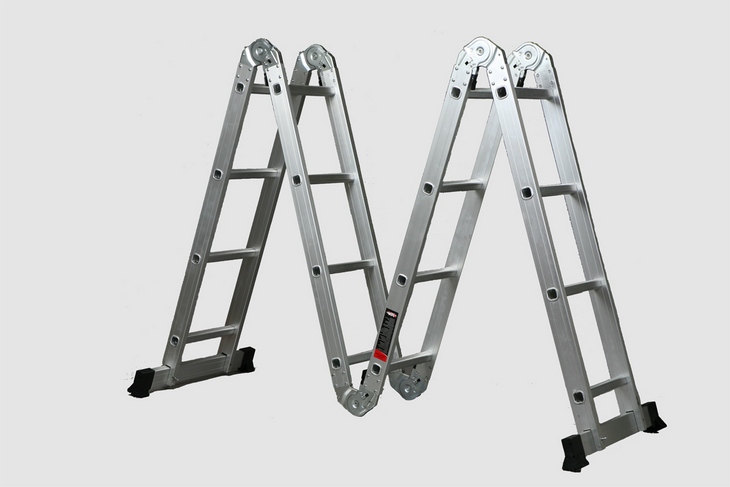
The 4-section step ladder has great possibilities in its use
Technical requirements for design and installation
The types of stairs in the house are extensive. They are considered in terms of functionality and usefulness. A vertical or horizontal staircase must meet a number of requirements. In this case, its operation is considered safe.
First of all, attention should be paid to the distance between the two walls and the length of the marches. There are a number of criteria and norms that must be adhered to without fail.
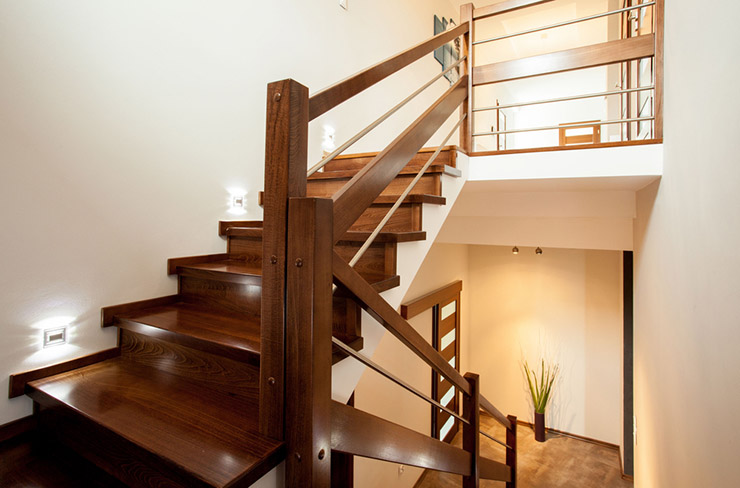 There are a number of requirements for stairs
There are a number of requirements for stairs
All types of stairs in a private house must be built on the basis of the rules:
- The maximum load on the handrail is 400 N.
- The platform and marches are made of durable and resistant materials such as aluminum and steel.
- The angle of inclination is not less than 20 degrees.
- The width of the platform between the fences should not be less than 0.8 m.
The owner is advised to first familiarize himself with what kind of stairs there are
Pay attention to the railings and sides. They must comply with the standards and rules of GOST
It doesn't matter which staircase to choose for a private house, the main thing is that it is comfortable. During the installation process, you will need to adhere to a number of rules.
It directly depends on the type of construction. The nature of the room is analyzed. It can be divided into two parts by design. Combined stairs are most often erected. On them it should be convenient to go down and think. Nothing can threaten a person.
In this video, you will learn more about stairs:
Straight
This is one of the most common types of stairs found in both residential and commercial properties.
The types of stairs can be distinguished even in a simple straight structure. The difference lies in the presence of an intermediate platform.
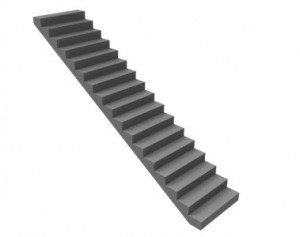
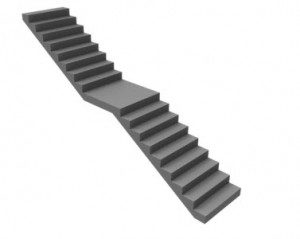
The types of straight stairs to the second floor may differ in style:
Scandinavian-style staircase;
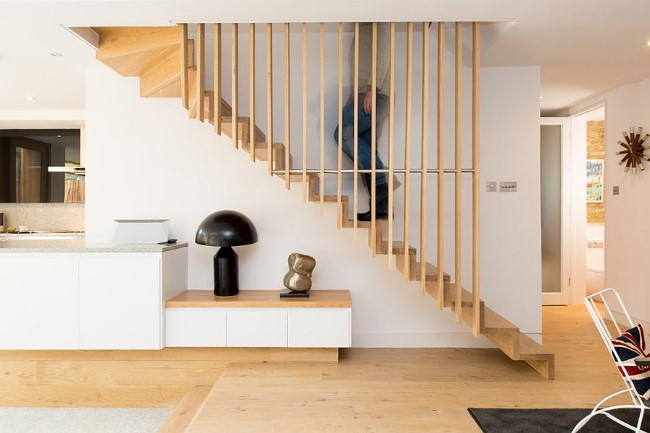
chalet-style staircase;
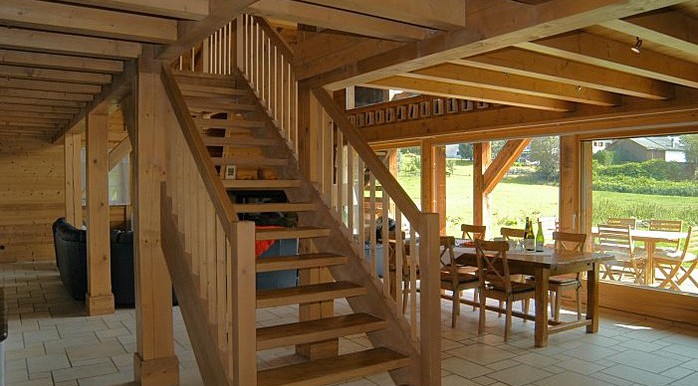
country style staircase;

in the loft style.

Advantages
- As a rule, this is the most convenient construction for movement.
- It is the easiest to make, but it depends on the level of detail in the design.
- Straight typical staircases are connected only from above and below, an intermediate supporting structure is not required, with the exception of an unusually long span or the presence of intermediate platforms.
- If you use steps without risers and thin metal elements of the supporting structure, the staircase will turn out to be more transparent and will not greatly obstruct the view behind it.
- Easy to install railing.
disadvantages
- Takes up a lot of space.
- Some types of stairs in the house provide additional support for the floors, the straight line does not perform this function.
- With a ceiling height of more than 3.5 m, an intermediate platform or additional reinforcement of the structure is required, all this leads to an increase in the occupied area. For this reason, the straight design is not often used in residential areas with high ceilings.
Pros and cons of telescopic spinning rods
The telescopic spinning rod, in comparison with the plug version, has one significant and indisputable advantage, which both experienced and novice spinningists agree with, and that is the compactness of the tackle. The main plus is that in the assembled state the size of the spinning rod does not exceed 50 cm and it can be carried without any problems in the car every day without worrying about the lack of space. In addition, in the assembled state, the thinnest parts of the tackle are protected by a strong first knee, and you should not worry about minor defects in the blank and a possible accidental quivertip hall during transportation.
The low cost of such products is also considered an important factor, which is also a positive parameter of the telescope. In view of their design features, telescopic tools have working parameters of the blank that are blurred in wide ranges of values, which makes the tackle, although rough, but still close in characteristics to a universal tackle, which can also be attributed to a plus. But no matter how we praise the telescope, it is significantly inferior to the plugs in the subtlety and delicacy of fishing. A large number of joints deprive the blank of the uniformity of the structure, and therefore, reduce all its working qualities, which is reflected in the low sensitivity of the gear.
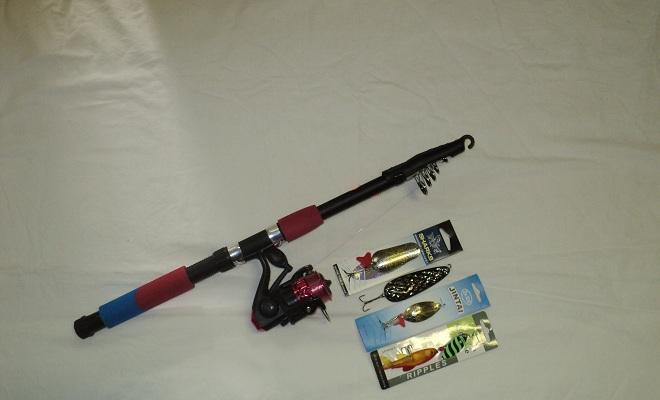
The telescope is not distinguished by its range and strength. Many connections do not impart reliability to the tackle, and such spinning rods are much heavier than plug options. To summarize, we can characterize this type of rod as a compact tool for transportation and storage, as well as educational purposes for developing spinning fishing skills, but not quite suitable for delicate hunting, which requires a scrupulous approach to the posting technique and the quality of fishing.
Folding attic stairs
If access to a room under the roof is needed periodically and the technical condition does not allow connecting it with a house, folding attic stairs are mainly used.
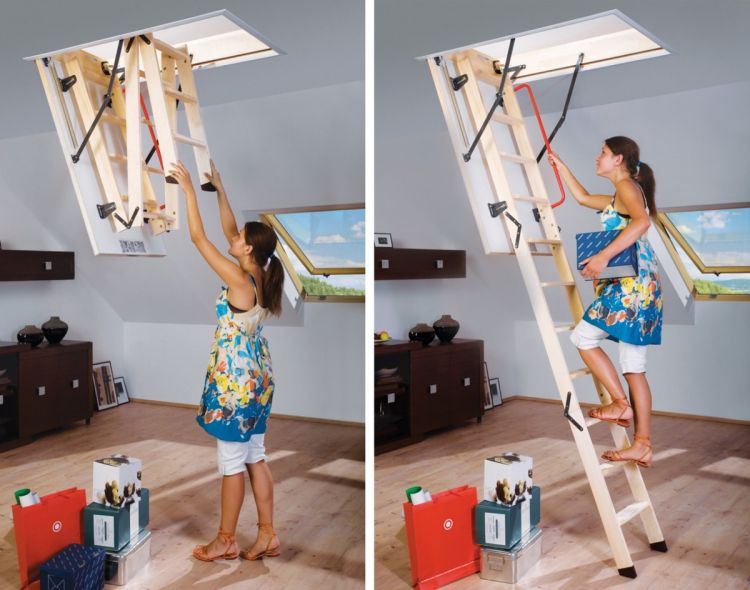
Lightweight, mobile and space-efficient, they are practically the reference solution to the problem of attic access.
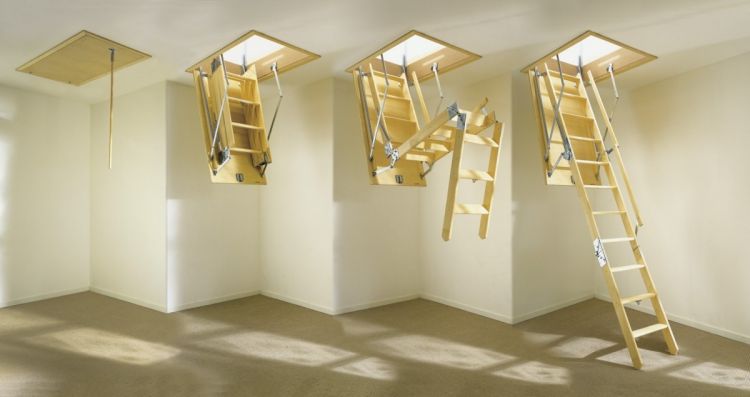
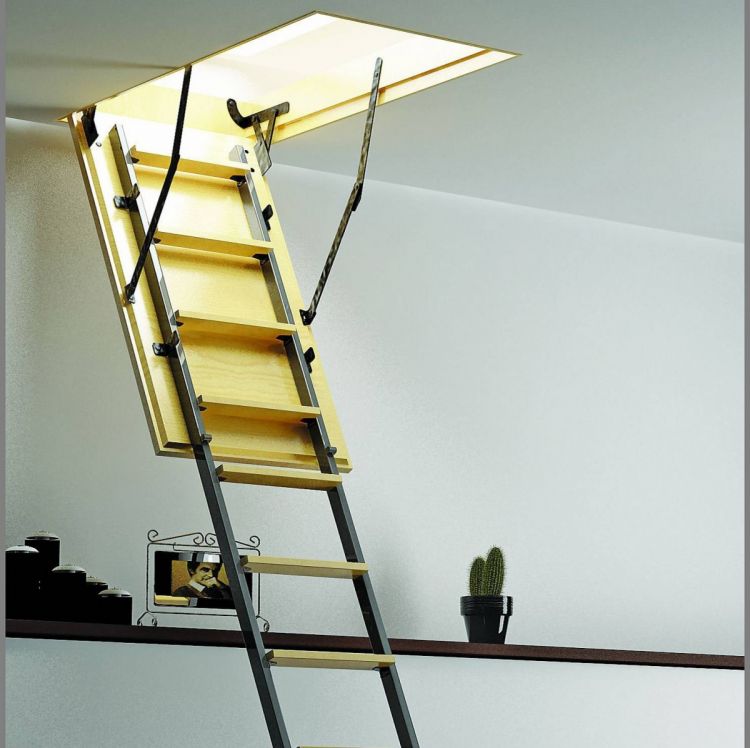

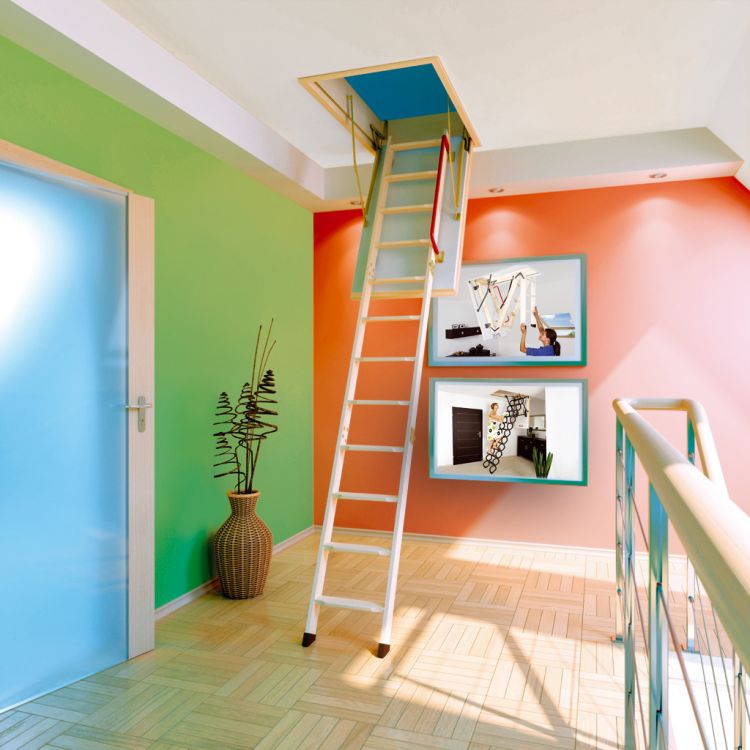
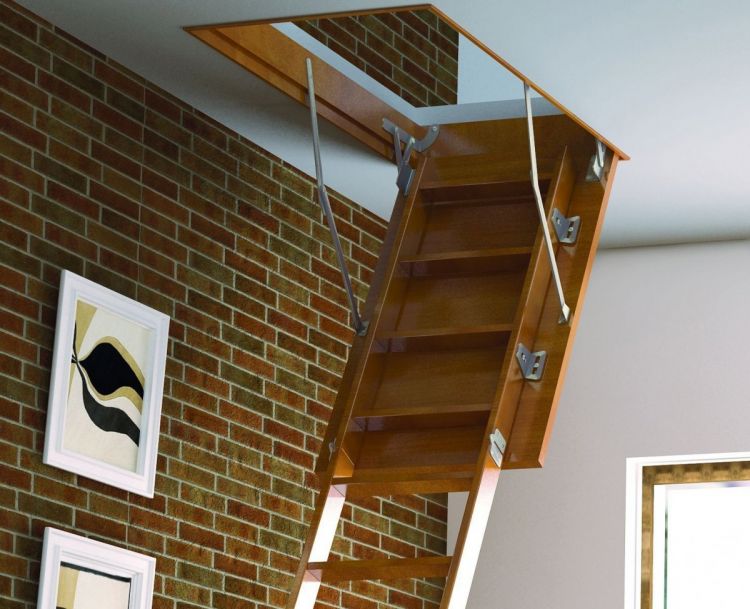

However, there is a limitation on the height of the ceilings, if it exceeds three and a half meters, then such an arrangement will be unsafe due to the high load and loose base.

There are several types of such stairs:
- sliding,
- scissor,
- folding,
- telescopic,
- folding.

Sliding attic staircase
A two-section option, in which one part is attached to the hatch (base), the second moves apart along the guides. Assembled sections are one on top of the other. With the general simplicity of manufacture and strength, it takes up a lot of space.
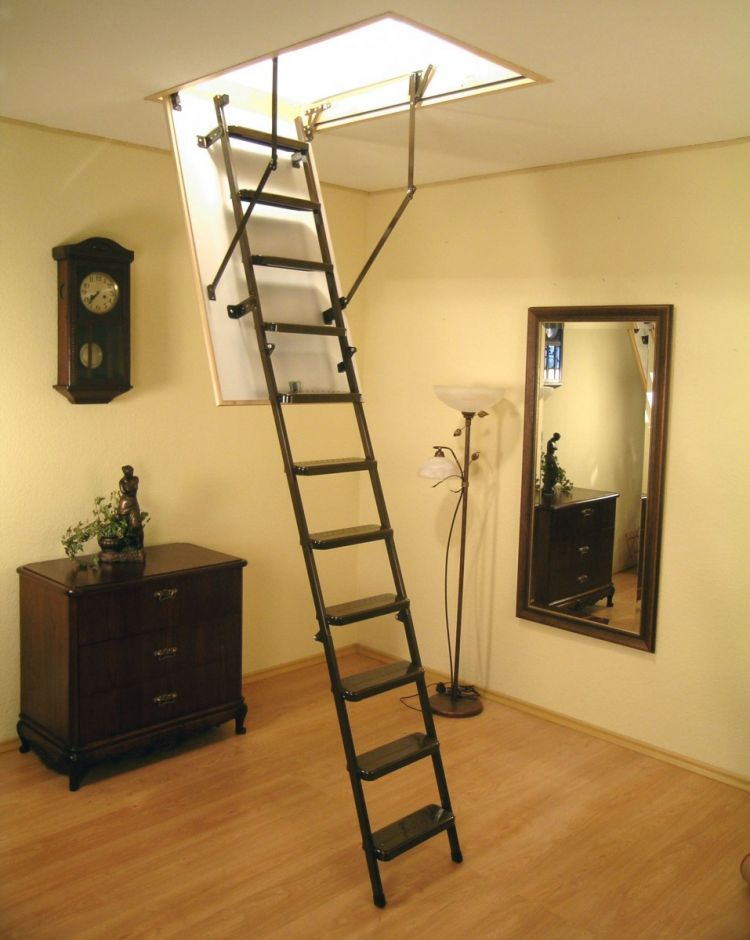
Scissor attic ladder
It is made mainly of metal, the assembled side mechanism closes like scissors, due to which it takes up little space, a very compact version. Requires regular lubrication, otherwise it may loosen and squeak.

Folding attic staircase
It can consist of two, three or four sections, connected by special hinges or hinges. Strength is given to it by the upper part rigidly fixed to the hatch, flexibility is maintained due to the fittings.
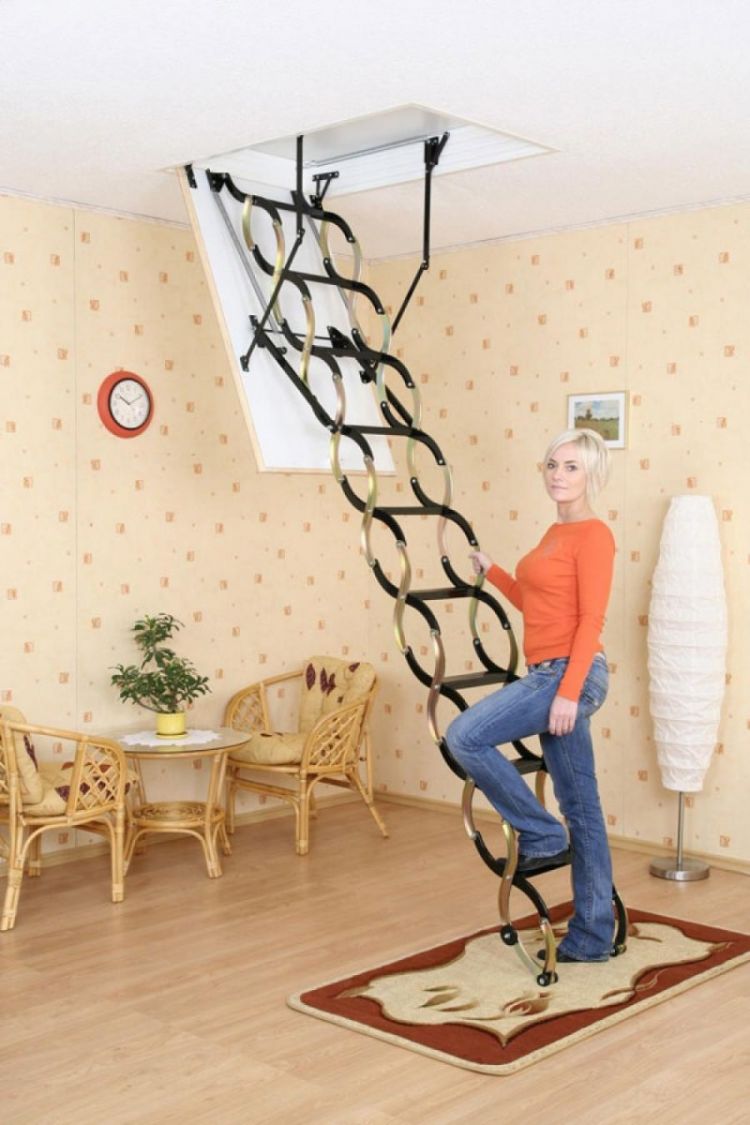
Telescopic loft ladder
Aluminum model, the parts of which are folded into one another. In general, a fairly strong and light product, but not popular on the Russian market, so it will be problematic to purchase it.

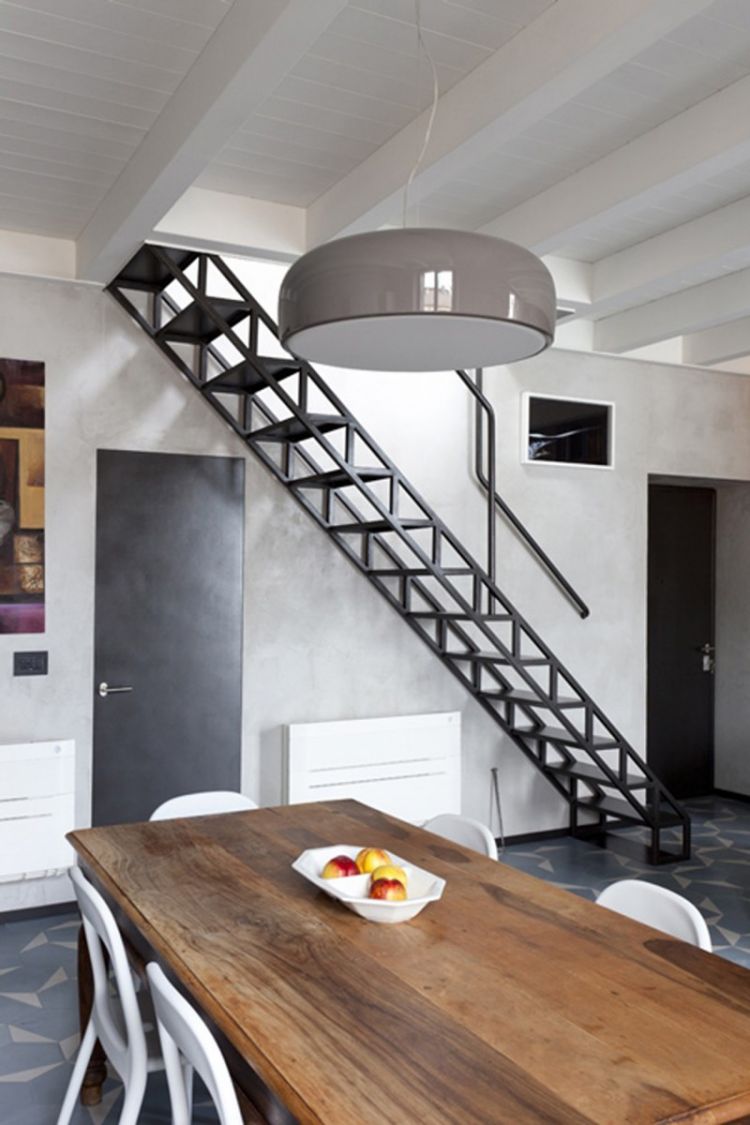
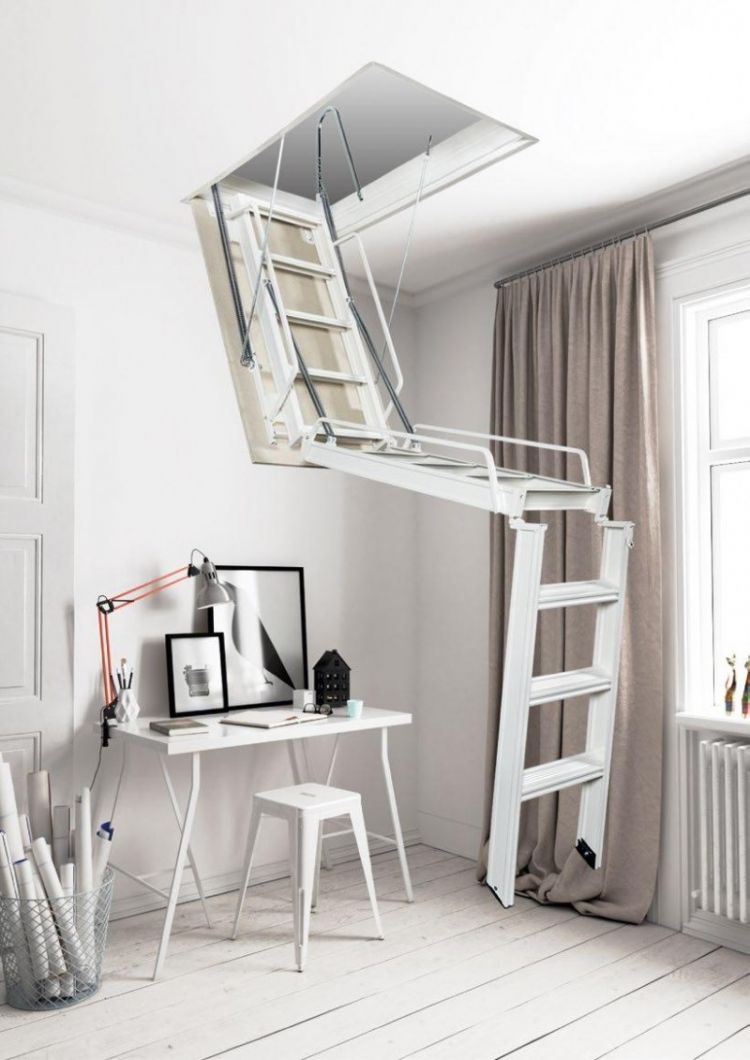
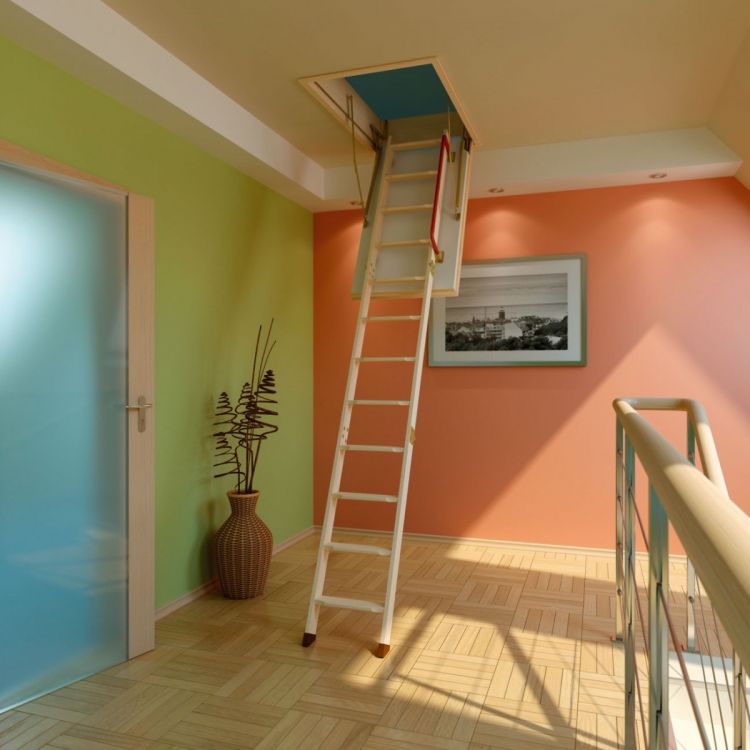


Folding attic staircase
Structurally, the staircase is complex and difficult to use, but due to its maximum compactness it remains in great demand.

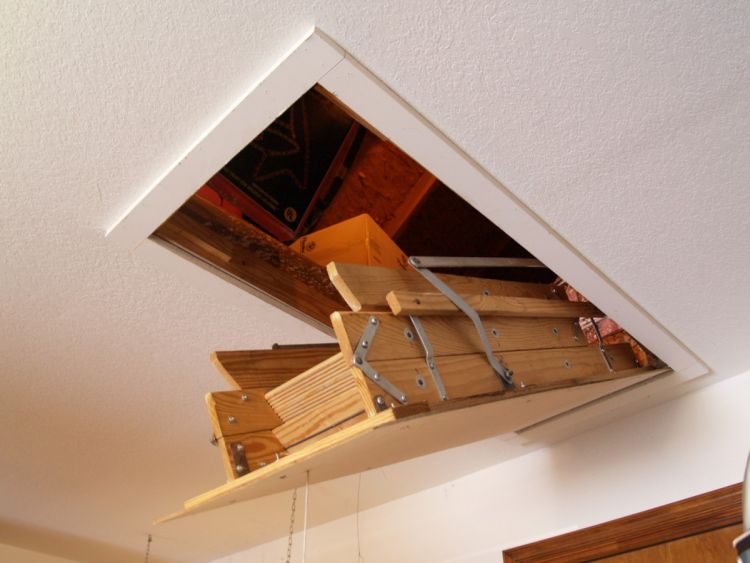
Components of ladders
Telescopic stepladders are a device consisting of several sections, which are interconnected by sliding mechanisms.  The step-ladder consists of:
The step-ladder consists of:
- Racks, which are the main support. It is desirable that they have rubber anti-slip attachments for greater stability.
- There are only 2 steps (in household ones, up to 24 in professional models), the step between them does not exceed 25 cm (usually from 20 to 25 cm). May vary in width. Wider steps provide better stability in operation. Embossed lugs on them, preventing slipping, ensure safety when descending / ascending. In some models, an additional rubberized coating may be present, which protects against possible electric shock when working with electricity. Load per step - maximum 150 kg.
- Handrail.They are not an obligatory part, therefore, they are not available in all models.

Stepladders
In their traditional design, these products are familiar to almost everyone, since they are most often used in everyday life. But telescopic ladders are less popular. Although they are more convenient to use in comparison with classical rigid structures. And when folded, they are much more compact and easier to store. There are two types of telescopic ladders:
- equilateral (in which the length and number of steps in both folding parts are the same);
- with different lengths of parts (in a fully unfolded state, one section protrudes upward above the other by 2-3 steps).

Each section of the double-sided telescopic stepladder can be individually expanded to the required length. Therefore, they can be installed on ledges or other uneven surfaces without the use of additional spacers or other fixtures.
To increase the stability of the product, one of the halves of the step-ladder in the lower part is equipped with an additional cross-beam, at the ends of which there are special tips that prevent the device from sliding on a very smooth floor.



